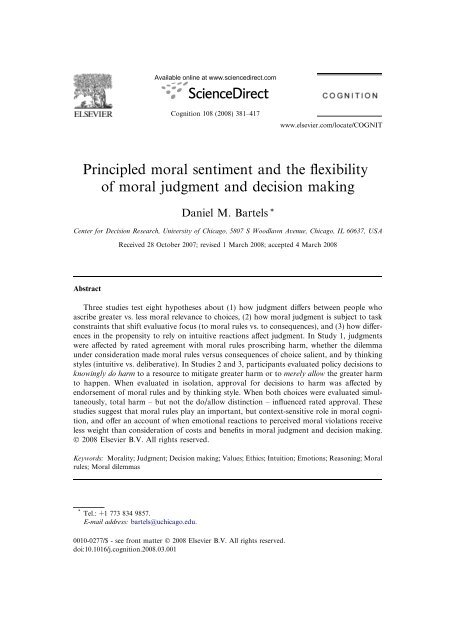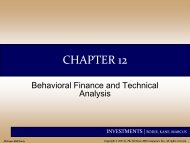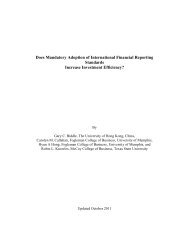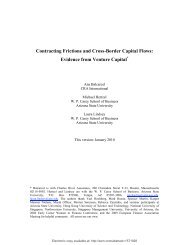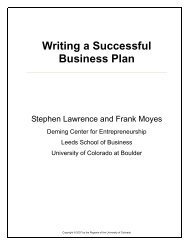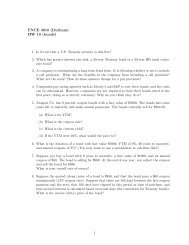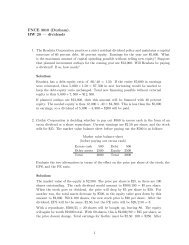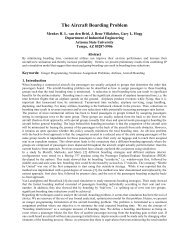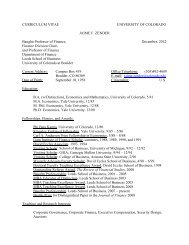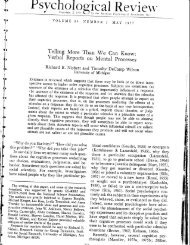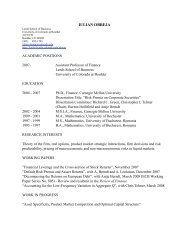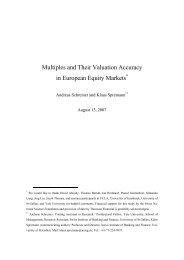Principled moral sentiment and the flexibility of moral judgment and ...
Principled moral sentiment and the flexibility of moral judgment and ...
Principled moral sentiment and the flexibility of moral judgment and ...
Create successful ePaper yourself
Turn your PDF publications into a flip-book with our unique Google optimized e-Paper software.
386 D.M. Bartels / Cognition 108 (2008) 381–417more likely <strong>the</strong> audience is, on reflection, to accept <strong>the</strong> utilitarian solution.” O<strong>the</strong>rutilitarians argue that because people’s intuitions are <strong>of</strong>ten elicited by ‘‘<strong>moral</strong>lyirrelevant” features, <strong>the</strong>y should be discarded, <strong>and</strong> rational analysis should form <strong>the</strong>basis <strong>of</strong> ethical <strong>the</strong>ory (for a book’s worth <strong>of</strong> examples, see Unger, 1996).Deontologists are not <strong>the</strong> only philosophers who construct cases to support <strong>the</strong>irarguments, however. Consequentialists have used ‘‘catastrophe cases” to elicit intuitionsthat are difficult to square with deontology, as illustrated in one deontologist’sreply to such cases:‘‘We can imagine extreme cases where killing an innocent person may save awhole nation. In such cases it seems fanatical to maintain <strong>the</strong> absoluteness<strong>of</strong> <strong>the</strong> <strong>judgment</strong>, to do right even if <strong>the</strong> heavens will in fact fall. And so <strong>the</strong> catastrophicmay cause <strong>the</strong> absoluteness <strong>of</strong> right <strong>and</strong> wrong to yield, but even <strong>the</strong>nit would be a non sequitur to argue (as consequentialists are fond <strong>of</strong> doing) thatthis proves that <strong>judgment</strong>s <strong>of</strong> right <strong>and</strong> wrong are always a matter <strong>of</strong> degree,depending on <strong>the</strong> relative goods to be attained <strong>and</strong> harms to be avoided.I believe, on <strong>the</strong> contrary, that <strong>the</strong> concept <strong>of</strong> <strong>the</strong> catastrophic is a distinct conceptjust because it identifies <strong>the</strong> extreme situations in which <strong>the</strong> usual categories<strong>of</strong> <strong>judgment</strong> (including <strong>the</strong> category <strong>of</strong> right <strong>and</strong> wrong) no longer apply.”(Fried, 1978, p.10).Normative ethical <strong>the</strong>ories intend to rationalize intuitive <strong>judgment</strong> <strong>and</strong> guidedeliberative <strong>moral</strong> reasoning. And, in cases where intuition <strong>and</strong> deliberation conflict,<strong>the</strong>y aim for resolution: ei<strong>the</strong>r discard <strong>the</strong> intuition (Unger, 1996) or add a ‘‘catastropheclause” to accommodate it (Fried, 1978). Study 1 examines preferences elicitedby st<strong>and</strong>ard <strong>and</strong> catastrophe case dilemmas. Specifically, Study 1 is motivated bydual-process models that link utilitarian <strong>judgment</strong> to deliberation <strong>and</strong> deontologyconsistent<strong>judgment</strong> to intuition.In Study 1, participants were presented with 14 dilemmas. Each dilemma had ast<strong>and</strong>ard version – where six people will die if one is not harmed – <strong>and</strong> two modifiedversions: a ‘‘vivid” <strong>and</strong> a ‘‘catastrophe” variant. The ‘‘vivid” variants add a redescription<strong>of</strong> <strong>the</strong> harmful act that is intended to make <strong>the</strong> scenario more (negatively)affect-laden, triggering <strong>sentiment</strong> like <strong>the</strong> outrage described by Donagan (above) <strong>and</strong>studied by Tetlock et al. (2000). Moral outrage is <strong>the</strong> ‘‘principled <strong>moral</strong> <strong>sentiment</strong>”that motivates a number <strong>of</strong> hypo<strong>the</strong>ses in <strong>the</strong> current studies. In Study 1, this outrageis expected to elicit deontology-consistent response. The ‘‘catastrophe” variantdescribes <strong>the</strong> group at risk as 20, ra<strong>the</strong>r than six people, making <strong>the</strong> cost <strong>of</strong> adheringto a deontological constraint more grave: Participants faced <strong>the</strong> decision <strong>of</strong> impartingharm for a net savings <strong>of</strong> 19 (ra<strong>the</strong>r than 5). I expect preferences more consistentwith utilitarianism for <strong>the</strong>se scenarios.2.1. Attributing utilitarianism to cold deliberation <strong>and</strong> deontology-consistentresponding to an emotional reactionJudgments elicited by dilemmas have proved useful exploring <strong>the</strong> contribution<strong>of</strong> automatic <strong>and</strong> controlled process to <strong>moral</strong> <strong>judgment</strong>. (e.g., Cushman, Young,
390 D.M. Bartels / Cognition 108 (2008) 381–417Mikhail (2007), for example, notes that emotion-based accounts are in need <strong>of</strong> anappraisal <strong>the</strong>ory – that merely noting that some perceived <strong>moral</strong> violations are associatedwith emotional responses misses, among o<strong>the</strong>r things, <strong>the</strong> important first step<strong>of</strong> interpreting <strong>the</strong> stimulus for evaluation. He manipulates <strong>the</strong> causal structure <strong>of</strong>trolley cases <strong>and</strong> finds that <strong>judgment</strong>s are sensitive to relatively nuanced distinctions(e.g., doing/allowing harm, treating people as means/ends, intentional harm/harmproduced as a side effect <strong>of</strong> good intentions). Sensitivity to <strong>the</strong>se features is suggestive<strong>of</strong> <strong>the</strong> operation <strong>of</strong> relatively narrowly-directed constraints. And, while <strong>the</strong>y do not<strong>of</strong>fer a computational <strong>the</strong>ory <strong>of</strong> appraisal, Nichols <strong>and</strong> Mallon’s (2006) affect-backednormative <strong>the</strong>ory postulates a set <strong>of</strong> rules that establish preconditions for <strong>judgment</strong>s<strong>of</strong> impermissibility.Instead <strong>of</strong> assuming constraints, Study 1 assesses participants’ endorsement <strong>of</strong>deontological principles using <strong>the</strong> Idealism subscale <strong>of</strong> Forsyth’s (1980) EthicsPosition Questionnaire (EPQ). Participants are asked rate agreement with deontologicalprinciples (many drawn from Kant, 1966/1785), <strong>the</strong> majority <strong>of</strong> whichconcern actions that harm humans or o<strong>the</strong>rwise violate people’s rights (e.g.,‘‘One should never psychologically or physically harm ano<strong>the</strong>r person,” <strong>and</strong>‘‘Risks to ano<strong>the</strong>r should never be tolerated, irrespective <strong>of</strong> how small <strong>the</strong> risksmight be”). One straightforward prediction is that people who indicate greateragreement with <strong>the</strong>se principles should demonstrate more deontological preferenceswhen asked to respond to ethical dilemmas. In o<strong>the</strong>r words, in <strong>the</strong> absence<strong>of</strong> rules proscribing harm, participants posed with <strong>the</strong> footbridge case should belikely to engage in a simple utilitarian calculus <strong>and</strong> view a five-lives-for-one trade<strong>of</strong>fpermissible.2.5. Hypo<strong>the</strong>sesPreference is expected to be most deontology-consistent for vividly-describeddilemmas, <strong>and</strong> most utilitarian for <strong>the</strong> catastrophe dilemmas. The vivid descriptions<strong>of</strong> harmful actions make <strong>the</strong>m seem more egregious, <strong>and</strong> because attention is directedto <strong>the</strong> act, I expect participants to view <strong>the</strong> actions as <strong>moral</strong> violations. Describing<strong>the</strong> consequences as especially grave serves to focus participants on <strong>the</strong> actions’ultimate consequences, thus directing attention away from <strong>the</strong> violation <strong>of</strong> a deontologicalconstraint.Deliberative thinkers are expected to exhibit more utilitarian preference than intuitivethinkers. Greene et al. (2001) suggest an ‘‘inhibition hypo<strong>the</strong>sis” – <strong>the</strong>y viewsome utilitarian <strong>judgment</strong>s as <strong>the</strong> product <strong>of</strong> deliberatively overriding <strong>the</strong> affectiveintuitions that (<strong>the</strong>y argue) fuel deontology-consistent response. Intuitive thinkers,who ‘‘trust <strong>the</strong>ir feelings,” will not be motivated to override <strong>the</strong>se feelings <strong>and</strong> will<strong>the</strong>refore demonstrate more deontology-consistent preference.The difference between intuitive <strong>and</strong> deliberative thinkers predicted above isexpected to be especially pronounced for responses collected from <strong>the</strong> affect-laden‘‘vivid” condition. Because <strong>the</strong> emotional signal associated with <strong>the</strong> harmful actionshould be stronger in this condition, deliberative thinkers will have to work evenharder to override <strong>the</strong> affectively pre-potent, deontological response.
Participants who indicate greater agreement with deontological constraints areexpected to exhibit less utilitarian preference. Ra<strong>the</strong>r than explaining deontologyconsistentpreference entirely in terms <strong>of</strong> a lower-order emotional reaction, deontologicalpreference may be principled. If participants’ decontextualized normativeperceptions (idealism) predict revealed preference, <strong>the</strong>n <strong>moral</strong> preference may beshaped, in part, by adherence to <strong>moral</strong> rules.2.6. MethodsD.M. Bartels / Cognition 108 (2008) 381–417 3912.6.1. ParticipantsSeventy-one undergraduates (45 females <strong>and</strong> 26 males) participated. They weretested in a small group setting (typically one to four participants per session).Ano<strong>the</strong>r unrelated study was also run during <strong>the</strong>se sessions. Eight participants didnot supply data for one <strong>of</strong> <strong>the</strong> predictor variables (noted below) because <strong>of</strong> time constraintson <strong>the</strong> experimental session introduced by <strong>the</strong> duration <strong>of</strong> <strong>the</strong> unrelatedstudy. All received partial course credit.2.6.2. Materials <strong>and</strong> designParticipants in this study completed two assessments <strong>of</strong> individual differences <strong>and</strong>indicated preferences for 14 ethical dilemmas. First, participants responded to a r<strong>and</strong>omizedordering <strong>of</strong> <strong>the</strong> Idealism subscale <strong>of</strong> Forsyth’s (1980) Ethics Position Questionnaire(see Appendix A). Second, participants read <strong>and</strong> gave <strong>judgment</strong>s for 14ethical dilemmas similar to <strong>the</strong> one below (Greene et al., 2001; see also Alda et al.,1983, <strong>and</strong> see Appendix B for a full list <strong>of</strong> <strong>the</strong> 14 scenarios). The ‘‘vividness” manipulationappears in brackets; <strong>the</strong> ‘‘catastrophe” manipulation appears in paren<strong>the</strong>ses:Enemy soldiers have taken over your village <strong>and</strong> will kill all remaining civilians.You <strong>and</strong> five (19) o<strong>the</strong>rs are hiding in <strong>the</strong> cellar <strong>of</strong> a large house. Soldiershave come to search <strong>the</strong> house for valuables. A baby in your group begins tocry. So, you cover her mouth, but she cannot brea<strong>the</strong>. If you remove yourh<strong>and</strong>, <strong>the</strong> baby can brea<strong>the</strong>, but her crying will summon <strong>the</strong> soldiers who willkill everyone in <strong>the</strong> cellar. [The baby is writhing around violently in your arms.With all her might, she desperately struggles to brea<strong>the</strong>].In this situation, would you smo<strong>the</strong>r <strong>the</strong> baby?NO-2 -1 +1 +2YESParticipants indicated <strong>the</strong>ir responses by clicking on one <strong>of</strong> <strong>the</strong> boxes. Responseswere recoded from zero to one (coded 0.00, 0.25, 0.75, 1.00) so that higher numbersindicated more utilitarian preferences. (The results do not crucially depend on how<strong>the</strong>se responses are scored. Analyses using different scoring methods – using just <strong>the</strong>
392 D.M. Bartels / Cognition 108 (2008) 381–417endpoints <strong>of</strong> <strong>the</strong> scale or <strong>the</strong> treating scale as a dichotomous measure – yield <strong>the</strong>same patterns as those reported below.)Each participant participated in all three conditions (St<strong>and</strong>ard, Catastrophe, Vivid)<strong>and</strong> responded to all 14 scenarios, but never responded to <strong>the</strong> same scenario twice (i.e.,never saw more than one version <strong>of</strong> a scenario). For each participant, roughly one-third<strong>of</strong> <strong>the</strong> stimulus scenarios were from each <strong>of</strong> <strong>the</strong> three experimental conditions.First, <strong>the</strong> order <strong>of</strong> presentation <strong>of</strong> <strong>the</strong> 14 dilemmas was r<strong>and</strong>omized for each participant.Second, <strong>the</strong> assignment <strong>of</strong> conditions to trials was r<strong>and</strong>omized for each participant,such that on every third trial, a participant responded to a st<strong>and</strong>ard/catastrophe/vivid dilemma. The permutation <strong>of</strong> conditions for each block <strong>of</strong> threetrials – whe<strong>the</strong>r Ps saw a st<strong>and</strong>ard dilemma, followed by a catastrophe, followedby a vivid dilemma, versus one <strong>of</strong> <strong>the</strong> o<strong>the</strong>r five possible permutations, was r<strong>and</strong>omlydetermined for each participant. This design ensured that each participant participatedin each condition, that each participant responded to each <strong>of</strong> <strong>the</strong> 14 items,<strong>and</strong> that no participant saw more than one version <strong>of</strong> an item.After responding to <strong>the</strong> ethical dilemmas, participants responded to a r<strong>and</strong>omizedordering <strong>of</strong> a modified, 20-item version <strong>of</strong> <strong>the</strong> REI (Epstein et al., 1996; Pacini &Epstein, 1999). For each item, participants rated <strong>the</strong>ir level <strong>of</strong> agreement with statementslike ‘‘I prefer to do something that challenges my thinking abilities ra<strong>the</strong>r thansomething that requires little thought” (where greater agreement suggests greaterreliance on analytic-deliberative thought) <strong>and</strong> ‘‘Using my gut feelings usually workswell for me in figuring out problems in my life” (where greater agreement suggestsgreater reliance on intuition; see Appendix A). Eight participants did not provideREI responses because <strong>of</strong> <strong>the</strong> time constraints placed on <strong>the</strong> experimental sessionsin which <strong>the</strong>y participated.2.7. Results <strong>and</strong> discussion2.7.1. Experimental results: Influence <strong>of</strong> vividness <strong>and</strong> catastrophe manipulationsStudy 1 found that <strong>the</strong> experimental manipulations produced effects in <strong>the</strong> predicteddirection. For <strong>the</strong> within-participants contrasts, I computed for each participant<strong>the</strong> average preference for <strong>the</strong> items <strong>the</strong>y viewed in each <strong>of</strong> <strong>the</strong> experimentalconditions. Overall, participants indicated less utilitarian preferences for <strong>the</strong> vividcondition items <strong>the</strong>y viewed (M = 0.37, SD = 0.19) than for <strong>the</strong> st<strong>and</strong>ard conditionitems (M = 0.45, SD = 0.19, paired-t(1, 70) = 2.86, p < .01). Forty-six <strong>of</strong> <strong>the</strong> 71 participantsshowed this effect. Also as predicted, participants indicated more utilitarianpreferences for <strong>the</strong> catastrophe items <strong>the</strong>y viewed (M = 0.54, SD = 0.20, pairedt(1,70) = 3.82, p < .001). Forty-eight participants showed this effect. As Table 1shows, <strong>the</strong> within-subjects contrast yielded a large effect F(2, 140) = 23.19, p < .001,g 2 p = .25), consistent with expectations.Most <strong>of</strong> <strong>the</strong> items exhibited similar effects. Recall that no participant saw morethan one version <strong>of</strong> a scenario. So, <strong>the</strong> item comparisons shown in Table 1 arebetween-subjects. Even though <strong>the</strong> within-participants row <strong>of</strong> Table 1 suggests a verylarge effect, <strong>the</strong> between-subjects contrast, controlling for <strong>the</strong> effects <strong>of</strong> <strong>the</strong> experimentalmanipulations, yields an F-value(1,70) <strong>of</strong> 663.69 <strong>and</strong> an effect size (g 2 p )<strong>of</strong>
D.M. Bartels / Cognition 108 (2008) 381–417 393Table 1Study 1: Effects <strong>of</strong> condition (vivid, st<strong>and</strong>ard, <strong>and</strong> catastrophe) on utilitarianism in <strong>moral</strong>ly-motivatedpreferenceContrast Vivid St<strong>and</strong>ard Catastrophe F-value (g 2 p )Footbridge 0.16 0.10 0.27 2.99 (.08)Submarine 0.50 0.49 0.68 2.25 (.06)Hostages 0.19 0.53 0.50 9.45 ** (.22)Surgery 0.06 0.13 0.18 1.63 (.05)Trespassers 0.26 0.28 0.40 1.34 (.04)Liferaft 0.31 0.56 0.64 5.90 ** (.15)Spelunkers 0.49 0.55 0.53 0.25 (.01)Derailment 0.44 0.52 0.63 1.85 (.05)Baby 0.49 0.53 0.59 0.79 (.02)Byst<strong>and</strong>er 0.65 0.73 0.77 1.09 (.03)Plane Crash 0.18 0.07 0.30 4.60 ** (.12)Fumes 0.63 0.65 0.80 1.94 (.05)Prisoners <strong>of</strong> War 0.49 0.49 0.69 3.41 * (.09)Soldiers 0.43 0.58 0.65 2.17 (.06)Within-Ps 0.37 0.45 0.54 23.19 ** (.25)Between-Ps 663.69 ** (.90)* p < .05.** p < .01.p < .10..90. Clearly, <strong>the</strong>re was wide variation in preferences even within this (potentiallyrestrictive) sample <strong>of</strong> undergraduates.2.7.2. Influence <strong>of</strong> individual differencesAll <strong>of</strong> <strong>the</strong> effects reported in this section appear in Table 2. The results for <strong>the</strong>average preference exhibited across all 14 responses were as predicted: <strong>the</strong> more aparticipant relied on intuition than deliberation, <strong>and</strong> <strong>the</strong> greater his or her endorsement<strong>of</strong> deontological principles, <strong>the</strong> more deontology-consistent were his or herpreferences (rs .39 <strong>and</strong> .32, both ps < .01). 1 Also consistent with expectations,<strong>the</strong> effect <strong>of</strong> thinking styles on preference was most pronounced for responses collectedfrom <strong>the</strong> vivid condition (r = .47, p < .01). These results <strong>of</strong>fer some supportfor an emotions-based account <strong>of</strong> <strong>moral</strong>ly-motivated preference something likeGreene et al’s (2001) inhibition hypo<strong>the</strong>sis. That is, some utilitarian responses (especiallythose where ‘‘<strong>the</strong> heart” tugs in one direction <strong>and</strong> ‘‘reason” in <strong>the</strong> o<strong>the</strong>r) areproduced by expending cognitive effort to inhibit <strong>the</strong> affectively pre-potent deontologicalresponse. In addition, <strong>the</strong> relationship between idealism <strong>and</strong> preference alsosuggests a role for deontological constraints.The results <strong>of</strong> Study 1 suggest that <strong>the</strong>re may be more than one type <strong>of</strong> <strong>moral</strong>ly-motivateddecision maker, <strong>and</strong> that <strong>moral</strong> preference is flexible. The results1 Men were scored as more deliberative than women; men provided higher REI scores (M = 0.98, SD =1.93) than women (M = -0.42, SD = 2.21, t (1, 61) = 2.51, p < .05, g p 2 = .09). I had no <strong>the</strong>oretical basis forpredicting this effect, <strong>and</strong> I have no explanation for it. There were no appreciable gender differences for any<strong>of</strong> <strong>the</strong> o<strong>the</strong>r variables measured in any <strong>of</strong> <strong>the</strong> current studies.
394 D.M. Bartels / Cognition 108 (2008) 381–417Table 2Study 1: Correlations between individual differences indices <strong>and</strong> utilitarianism <strong>moral</strong>ly-motivatedpreference across experimental conditions (vivid, st<strong>and</strong>ard, <strong>and</strong> catastrophe)Experimental conditionAverage Vivid St<strong>and</strong>ard CatastropheThinking styles .39 ** .47 ** .20 .25 *Idealism .32 ** .33 ** .26 * .19* p < .05.** p < .01.suggest that participants who affirm deontological principles, <strong>and</strong> that intuitivethinkers, exhibit preferences more consistent with deontology. Results alsosuggest that focusing participants’ attention on violations <strong>of</strong> constraints – byexacerbating negative emotional reactions to <strong>the</strong>se actions – promotes deontology-consistentchoice. Study 1 also found that participants were willing tosacrifice human lives (in <strong>the</strong> catastrophe condition) if enough lives can be savedby doing so.2.7.3. Why <strong>the</strong> generalizability <strong>of</strong> Study 1’s results is limitedAs noted earlier, researchers studying responses elicited by dilemmas sometimesexhibit what Tetlock et al. (1996) refer to as <strong>the</strong> anti-context (people as r<strong>and</strong>om replicates)<strong>and</strong> anti-content (items as r<strong>and</strong>om replicates) biases. Study 1 partially avoids<strong>the</strong> anti-context bias by accounting for within-sample variance: participants who aremore likely to override emotional influence appear more utilitarian, <strong>and</strong> those whoendorse <strong>moral</strong> rules demonstrate preferences more consistent with <strong>the</strong> operation <strong>of</strong>those <strong>moral</strong> rules. However, since Study 1 uses only trolley-like dilemmas, <strong>the</strong> generalizability<strong>of</strong> <strong>the</strong>se results is limited.Studies 2 <strong>and</strong> 3 use o<strong>the</strong>r types <strong>of</strong> scenarios. Recall Hare’s (1981) wry commentabout ‘‘playing trains,” that is, <strong>the</strong> questionable relevance <strong>of</strong> intuitions <strong>and</strong> preferenceselicited by those abstract – <strong>and</strong>, he argues – highly artificial stimuli. His contentionwas that intuitions generated for more natural stimuli are more likely to beutilitarian. At a minimum, researchers should be wary about generalizing <strong>the</strong> set <strong>of</strong>processing principles implicated in response to dilemmas to o<strong>the</strong>r choice contexts.Studies 2 <strong>and</strong> 3 are, in this way, conceptual replication <strong>and</strong> generalization studies,<strong>and</strong> use as contexts <strong>the</strong> types <strong>of</strong> policy-level decisions for which, utilitarians argue,<strong>the</strong>ir <strong>the</strong>ory is especially well-suited (Goodin, 1993).3. Protected values as affect-backed constraints: Moral <strong>judgment</strong> in separate (Study 2)<strong>and</strong> joint evaluation (Study 3)Studies 2 <strong>and</strong> 3 examine whe<strong>the</strong>r <strong>and</strong> when we should expect <strong>moral</strong> values toengender nonconsequentialist decision principles by investigating PV-drivenresponse in two evaluative contexts: absolute <strong>and</strong> comparative <strong>judgment</strong>.
D.M. Bartels / Cognition 108 (2008) 381–417 395Research on protected values suggests that when contemplating <strong>the</strong> exchange <strong>of</strong> acherished resource (for which people have a PV), people may reason differently(invoking <strong>moral</strong> rules) than when reasoning about resources not tied to one’s <strong>moral</strong>values (Baron & Spranca, 1997). In some cases, people react to proposed trade<strong>of</strong>fswith <strong>moral</strong> outrage (Tetlock, 2002), <strong>and</strong> disavow consideration <strong>of</strong> costs <strong>and</strong> benefits.Baron <strong>and</strong> Spranca (1997) describe PVs as a subset <strong>of</strong> deontological rules that aretied to affect – rules that concern actions, like ‘‘do no harm”, but not <strong>the</strong> consequences<strong>of</strong> those actions.For present purposes, <strong>the</strong> PV framework <strong>of</strong>fers a way to select <strong>the</strong> domains forwhich we might expect deontology-consistent <strong>judgment</strong>. To assess PVs, participantsare presented with statements concerning <strong>the</strong> acceptability <strong>of</strong> trade<strong>of</strong>fs, as below:Causing <strong>the</strong> extinction <strong>of</strong> fish species.(a) I do not object to this.(b) This is acceptable if it leads to some sort <strong>of</strong> benefits (money or something else)that are great enough.(c) This is not acceptable no matter how great <strong>the</strong> benefits.People who endorse ‘‘c” are counted as having a PV for that resource (Ritov &Baron, 1999). People with PVs appear more sensitive to <strong>the</strong> distinction betweendoing <strong>and</strong> allowing harm <strong>and</strong> less sensitive to <strong>the</strong> consequences <strong>of</strong> <strong>the</strong>ir choices thanpeople without PVs, resulting in what Baron et al. call an ‘‘omission bias” (Ritov &Baron, 1999; Spranca, Minsk, & Baron, 1991).So, how rigidly nonconsequentialist are preferences for domains governed byPVs? Do people with PVs care less about <strong>the</strong> consequences than people withoutPVs? Perhaps. First, <strong>the</strong> measurement suggests a lack <strong>of</strong> concern with consequences– ‘‘no matter how great <strong>the</strong> benefits”. Second, omission bias is consistent with commitmentto <strong>moral</strong> prohibitions. That people with PVs prefer omission over a harmfulaction in contexts where <strong>the</strong> consequences favor action suggests PV-driven preferenceis consistent with a rigid deontology (Baron & Spranca, 1997).Are people absolutist deontologists for domains governed by PVs? Perhaps not.People who care more about not harming <strong>the</strong> resource might also care more about<strong>the</strong> consequences <strong>of</strong> an act. Based on this logic, Bartels <strong>and</strong> Medin (2007) examined<strong>the</strong> PV-driven preference using two procedures. Using a procedure that focusedattention on whe<strong>the</strong>r a harmful action should be taken to maximize net benefits,PVs were associated with nonconseqentialist response. Using a procedure that highlights<strong>the</strong> net costs averted by such actions, <strong>the</strong> trend reverses – people with PVsappeared more consequentialist than people without PVs. These results make senseif people with PVs for a resource care more about not harming <strong>the</strong> resource <strong>and</strong>about <strong>the</strong> consequences <strong>of</strong> actions in <strong>the</strong> domain.Study 1 suggests <strong>moral</strong> cognition is influenced by rules <strong>and</strong> whe<strong>the</strong>r attention isdirected to a harmful act or to its consequences. Studies 2 <strong>and</strong> 3 exp<strong>and</strong> on <strong>the</strong>sefindings, using accounts <strong>of</strong> people’s responses to dilemmas to investigate <strong>the</strong>context-sensitive role <strong>of</strong> PVs in <strong>moral</strong> <strong>judgment</strong>. In particular, PVs appear toshare important properties with affect-backed constraints (Nichols & Mallon,
396 D.M. Bartels / Cognition 108 (2008) 381–4172006). Violating PVs elicits emotional response – trade<strong>of</strong>fs <strong>of</strong> PVs can elicit extremeanger (Baron & Spranca, 1997). But just as even affect-backed rules can be overwhelmedif attention is directed to catastrophic consequences favoring infringing<strong>the</strong>m, Bartels <strong>and</strong> Medin (2007) showed that people’s willingness to accept trade<strong>of</strong>fs<strong>of</strong> PVs depends on where attention is focused.3.1. Protected values as affect-backed constraintsStudies 2 <strong>and</strong> 3 examine whe<strong>the</strong>r PVs operate like affect-backed constraints in<strong>moral</strong> <strong>judgment</strong>. In <strong>the</strong>se studies, participants rate <strong>the</strong>ir approval <strong>of</strong> governmentadministrators’ decisions. In Study 2, <strong>the</strong>y also judge whe<strong>the</strong>r <strong>the</strong> administrators’decisions violate a <strong>moral</strong> rule (<strong>judgment</strong>s <strong>of</strong> ‘‘weak impermissibility”).For each scenario, each <strong>of</strong> two administrators chooses ei<strong>the</strong>r to knowingly doharm to a resource to mitigate even greater harm or to allow <strong>the</strong> harm to happen.For example, participants read that 20 species <strong>of</strong> fish upstream would be madeextinct unless a dam is opened, but that opening <strong>the</strong> dam will kill some species downstream(see Appendix C). One administrator desires to do no harm (<strong>and</strong> thus not toact), <strong>and</strong> so 100% <strong>of</strong> <strong>the</strong> anticipated harm results. For example, ‘‘Paul does not wantto kill any <strong>of</strong> <strong>the</strong> fish species downstream. So, <strong>the</strong> dam is not opened. The 20 speciesupstream die.” I refer to <strong>the</strong>se choices as ‘‘omission.”The o<strong>the</strong>r administrator first calculates that by intervening, he or she will kill 80%<strong>of</strong> <strong>the</strong> resources, <strong>and</strong> based on this analysis, he or she chooses to intervene. Forexample, ‘‘David wants to save <strong>the</strong> fish species upstream. He first calculates that opening<strong>the</strong> dam will kill 16 species downstream. Knowing that doing so will kill many fish,he chooses to open <strong>the</strong> dam.” I refer to <strong>the</strong>se choices as ‘‘action.” Note that <strong>the</strong> administrator’sintent to save <strong>the</strong> species is given so that participants will not mistakenlyassume malicious intent. Study 2 presents <strong>the</strong> decisions in separate evaluation: ona given trial, participants evaluate ei<strong>the</strong>r <strong>the</strong> omission or <strong>the</strong> action, but not both.In Study 3, both are evaluated on a single trial.Recall that in Nichols <strong>and</strong> Mallon (2006), weakly impermissible actions – thosethat violated rules but failed to elicit an emotional response – were less likely tobe judged wrong, all things considered (‘‘all-in impermissibility”) than violations<strong>of</strong> affect-backed rules. By relating <strong>judgment</strong>s <strong>of</strong> rule violation <strong>and</strong> something akinto all-in impermissibility – (dis)approval <strong>of</strong> a government administrator’s decision– Study 2 <strong>of</strong>fers a test <strong>of</strong> whe<strong>the</strong>r PVs operate like affect-backed constraints. Therelationship between <strong>the</strong>se <strong>judgment</strong>s is predicted to be stronger for domains governedby PVs.This test relates to Feldman <strong>and</strong> Lynch’s (1988) approach to ‘‘self-generatedvalidity” – an explanation <strong>of</strong> how <strong>judgment</strong>s elicited by one probe can influence<strong>judgment</strong>s elicited by a subsequent probe. They argue that an earlier response willbe used as <strong>the</strong> basis for a subsequent <strong>judgment</strong> if <strong>the</strong> former is accessible <strong>and</strong> perceivedto be more diagnostic than o<strong>the</strong>r accessible inputs. In Study 2, when one’s<strong>judgment</strong> <strong>of</strong> whe<strong>the</strong>r a rule has been violated is diagnostic for whe<strong>the</strong>r or not oneapproves <strong>of</strong> a decision, one need not weigh o<strong>the</strong>r considerations. Especially consideringhow constraints preclude o<strong>the</strong>r considerations – like <strong>the</strong> goods to be promoted
D.M. Bartels / Cognition 108 (2008) 381–417 397by violating <strong>the</strong> rule – we might expect people with affect-backed constraints (PVs) totreat <strong>judgment</strong>s <strong>of</strong> rule violation <strong>and</strong> decision approval as <strong>the</strong> same <strong>judgment</strong>. Innormative deontological <strong>the</strong>ory, <strong>the</strong>se <strong>judgment</strong>s collapse into one: actions that violatedeontological constraints are wrong, simpliciter.3.2. Joint versus separate evaluation preference reversalsStudy 1 showed that utilitarian preference can be promoted or diminished bytask-induced attentional effects. Studies 2 <strong>and</strong> 3 examine whe<strong>the</strong>r <strong>moral</strong> value-drivenfocus on rules <strong>and</strong> consequences is subject to a different set <strong>of</strong> task constraints. Study2 asks participants to evaluate decisions in separate evaluation. Study 3 presentsdecisions in joint evaluation, inviting a comparison between options before rendering<strong>judgment</strong>.Previous research demonstrates that attributes that appeal to one’s intuitive sensibilities,<strong>and</strong> attributes that are o<strong>the</strong>rwise easy to evaluate, drive preference in separateevaluation (where a number <strong>of</strong> o<strong>the</strong>rwise useful comparisons are not madeavailable), whereas attributes that appeal to ‘‘colder”, more logical sensibilities drivepreference in joint evaluation (Bazerman, Moore, Tenbrunsel, Wade-Benzoni, &Blount, 1999). For example, Hsee <strong>and</strong> Leclerc (1998) asked three groups to assignbuying prices to an ice cream product. One group was asked to evaluate a 7-oz servingpresented in a 5-oz cup, a second group evaluated an 8-oz serving in a 10-oz cup,<strong>and</strong> a third assigned buying prices to both.Participants in <strong>the</strong> first condition were willing to pay more for <strong>the</strong> 7-oz servingthan participants in <strong>the</strong> second condition were willing to pay for <strong>the</strong> 8-oz serving.In separate evaluation, participants incorporated feelings about <strong>the</strong> cup being overfilled/underfilledinto <strong>the</strong>ir evaluative <strong>judgment</strong>. In <strong>the</strong> joint evaluation condition,where participants are able to select <strong>the</strong> most important attribute for setting a buyingprice, buying prices were greater for <strong>the</strong> 8-oz serving than <strong>the</strong> 7-oz serving.One interpretation <strong>of</strong> this preference reversal is that people discard intuitive reactionswhen comparison highlights a more sensible basis for evaluation, <strong>and</strong> this is onebasis <strong>of</strong> argumentation in normative ethics. Deontology tries to systematize our<strong>moral</strong> intuitions in <strong>the</strong> context <strong>of</strong> an over-arching <strong>the</strong>ory, accommodating <strong>the</strong> ‘‘outrage”we feel when contemplating some forms <strong>of</strong> sacrifice in <strong>the</strong> name <strong>of</strong> promotingutilitarian considerations (e.g., Donagan, 1977). In o<strong>the</strong>r words, good normative <strong>the</strong>oryshould accommodate <strong>moral</strong> intuitions – <strong>the</strong>y are honored as meaningful data in<strong>the</strong> development <strong>of</strong> normative ethical <strong>the</strong>ory. Some utilitarians suggest we shoulddiscard intuitions <strong>and</strong> instead rely on very basic <strong>moral</strong> values, like promoting totalwell-being. Unger (1996) does this by inviting comparison between scenarios thatillustrate to <strong>the</strong> reader that her intuitive <strong>judgment</strong>s for one case are premised on afactor that is clearly irrelevant in a structurally similar case.Joint evaluation <strong>of</strong>fers a strong test <strong>of</strong> <strong>the</strong> normative status people give to deontology-relevant<strong>and</strong> utilitarian-relevant attributes (Bazerman & Messick, 1998).Studies 2 <strong>and</strong> 3 assess whe<strong>the</strong>r disapproval for violations <strong>of</strong> PVs is overwhelmedwhen <strong>the</strong> consequences favoring violating a PV are made salient in joint evaluation.That is, Study 3 tests whe<strong>the</strong>r people invest <strong>the</strong> doing/allowing harm distinction with
D.M. Bartels / Cognition 108 (2008) 381–417 3993.5. Methods3.5.1. ParticipantsForty-eight undergraduates (25 women <strong>and</strong> 23 men) participated in Study 2 forpartial course credit. They were tested in a small group setting (typically one t<strong>of</strong>our participants per session). Those participants who wrote <strong>the</strong>ir contact informationon a sign-up sheet for Study 3 were contacted about participating in <strong>the</strong> secondround <strong>of</strong> data collection, conducted 61 to 71 days later. Thirty-two <strong>of</strong> <strong>the</strong>original 48 (18 women <strong>and</strong> 14 men) participated in Study 3 in exchange for $5compensation. (Those who returned to participate in Study 3 did not differ fromthose who did not return on any <strong>of</strong> <strong>the</strong> predictor or criterion variables – allts < 1).3.5.2. Materials <strong>and</strong> designIn each session, participants completed one <strong>of</strong> three packets that differed only in<strong>the</strong> pseudo-r<strong>and</strong>omized ordering <strong>of</strong> items within each type (PV items, Rational-Experiential Inventory items [REI completed once, in Study 2], <strong>judgment</strong> scenarios).First, participants responded to 30 PV items – seven that corresponded to <strong>the</strong> <strong>judgment</strong>scenarios intermixed with 23 unrelated PV items. Then, participants respondedto a modified, 20-item version <strong>of</strong> <strong>the</strong> REI (see Appendix A). Finally, participantsevaluated two governmental administrators’ choices for seven problems. The 14<strong>judgment</strong> scenarios crossed two types <strong>of</strong> decisions (omission, action) with sevenproblems (birds, children, dolphins, fish, jobs, poor, trees). The two versions <strong>of</strong><strong>the</strong> ‘‘Children” problem appear below:(Name) is considering a vaccination program. Epidemiologists estimate thatvaccinating 600 children will prevent <strong>the</strong>m from dying from an epidemic <strong>of</strong> anew infectious disease. The vaccine itself will kill some number <strong>of</strong> childrenbecause it sometimes causes <strong>the</strong> same disease. Because this disease progressesrapidly, a decision must be made quickly, <strong>and</strong> <strong>the</strong> government’s options areseverely constrained.Julie does not want to kill any <strong>of</strong> <strong>the</strong> children with <strong>the</strong> vaccine. So, <strong>the</strong> vaccine isnot administered. The 600 children die.Rich wants to save <strong>the</strong> children from <strong>the</strong> disease. He first calculates that administering<strong>the</strong> vaccine will kill 480 children. Knowing that doing so will kill many children,he chooses to vaccinate <strong>the</strong> children.In Study 2, after reading about <strong>the</strong> administrator’s decision, participants wereasked to assess whe<strong>the</strong>r or not <strong>the</strong> administrator broke a <strong>moral</strong> rule. The item read,‘‘By (not) administering <strong>the</strong> vaccine, (Julie) Rich broke a <strong>moral</strong> rule.” Participantsindicated agreement on a -3 (Strongly Disagree) to +3 (Strongly Agree) scale. Then,in Study 2, participants were asked, ‘‘How do you feel about (Julie’s) Rich’s decision?”Participants indicated approval or disapproval by circling a partitioning markon a scale ranging from ‘‘Strongly Disapprove” (coded as 1 for <strong>the</strong> analyses that follow)to ‘‘Strongly Approve” (coded as 8).
400 D.M. Bartels / Cognition 108 (2008) 381–417In Study 3, participants read about both decisions before being asked to evaluateeach. Before <strong>the</strong> first decision presented on a page, participants read ‘‘Suppose thisproblem has been assigned to (Name)”, <strong>and</strong> <strong>the</strong>n read ‘‘Now suppose, instead, thatthis problem has been assigned to (Name)” between <strong>the</strong> first <strong>and</strong> second decision.Participants <strong>the</strong>n rated <strong>the</strong>ir approval or disapproval <strong>of</strong> each decision as <strong>the</strong>y didin Study 2.For each <strong>of</strong> <strong>the</strong> three packets, <strong>the</strong> order <strong>of</strong> problems (i.e., birds, children, etc.) wasr<strong>and</strong>omized. For Study 2, <strong>the</strong> assignment <strong>of</strong> action type to <strong>the</strong> problems was r<strong>and</strong>omizedso that on every o<strong>the</strong>r trial, participants evaluated an omission (or anaction).3.6. ResultsTo assess whe<strong>the</strong>r <strong>moral</strong> <strong>judgment</strong> differs according to whe<strong>the</strong>r <strong>the</strong> domain is governedby protected values, I first report analyses <strong>of</strong> within-subjects effects where Iseparated <strong>the</strong> items for which each participant endorsed a PV (referred to as‘‘PV”) from <strong>the</strong> items for which he or she did not (referred to as ‘‘No PV”). I alsoreport analyses conducted for each item.3.6.1. Rule violations <strong>and</strong> approval (Study 2)For each participant, I computed correlations between <strong>judgment</strong>s <strong>of</strong> <strong>moral</strong> ruleviolation (i.e., ‘‘weak impermissibility”) <strong>and</strong> approval ratings across PV <strong>and</strong> NoPV items. I predicted that violations <strong>of</strong> <strong>moral</strong> rules would elicit strong disapprovalratings for domains governed by PVs. I found that, in general, when participantsperceived rule violations, <strong>the</strong>y disapproved <strong>of</strong> <strong>the</strong> administrators’ decisions. Thisrelationship held for No PV items (M = .66), <strong>and</strong> as predicted, was stronger forPV items (M = .84; Wilcoxon signed ranks test for related samples Z = 2.42,p < .05; both sets <strong>of</strong> within-Ps correlations reliably negative by signed ranks tests360.5, 388, ps < .001). This finding is consistent with <strong>the</strong> notion that PVs functionlike affect-backed constraints in influencing <strong>moral</strong> <strong>judgment</strong>.As a reviewer pointed out, <strong>the</strong> overall relationship between <strong>judgment</strong>s <strong>of</strong> ruleviolation <strong>and</strong> disapproval is also consistent with an ‘‘emotional reaction hypo<strong>the</strong>sis”whereby participants indicate <strong>the</strong>ir negative emotional response by registeringnegative evaluative <strong>judgment</strong>s on both probes. After all, both Haidt, Koller,<strong>and</strong> Dias (1993) <strong>and</strong> Cushman et al. (2006) report evidence that people sometimesappeal to <strong>moral</strong> principles that cannot explain <strong>the</strong>ir behavior. Althoughthis alternative explanation cannot be ruled out by <strong>the</strong>se data, <strong>the</strong>re may be reasonsto favor taking people’s <strong>judgment</strong> <strong>of</strong> rule violation in Study 2 at face valueover <strong>the</strong> emotional reaction hypo<strong>the</strong>sis. Previous studies demonstrate that participantsbehave in a manner consistent with <strong>the</strong> idea that harmful actions, but notnecessarily omissions, violate <strong>moral</strong> rules (Baron & Spranca, 1997). As noted,Cushman et al. (2006) find that participants sometimes invoke principles thatcannot explain <strong>the</strong>ir behavior, but notably, when participants in <strong>the</strong>ir studieswere asked to justify why actions <strong>and</strong> omissions with equivalent consequenceselicited discrepant <strong>judgment</strong>s from <strong>the</strong>m, participants were able to reliably gener-
D.M. Bartels / Cognition 108 (2008) 381–417 401ate <strong>the</strong> action/omission distinction (but not o<strong>the</strong>r principles) as <strong>the</strong> normativelyrelevant factor.3.6.2. Approval ratings – Separate evaluation (Study 2)For each participant, I calculated four averages: one each for <strong>the</strong> participant’sapproval ratings for omissions/actions on items for which he or she endorsed/didnot endorse a PV. Recall that in <strong>the</strong> current design, actions resulted in better consequences(80% loss) than omissions (100% loss). In Study 2, this comparison wasunavailable to participants, leaving emotional reactions to drive (dis)approval.I expected that for domains governed by PVs, decisions to knowingly do harm on<strong>the</strong> basis <strong>of</strong> explicit cost-benefit reasoning would be considered <strong>of</strong>fensive (violations<strong>of</strong> PVs – rules like ‘‘do no harm” – elicit anger), eliciting greater disapproval fromparticipants than similar choices made for o<strong>the</strong>r domains. I also predicted that thistendency would be more pronounced for intuitive thinkers, who might be less likelyto override <strong>the</strong>ir emotional reaction than deliberative thinkers. The results <strong>of</strong> a 2(Decision: Action/Omission) 2 (Domain: No PV/PV) repeated-measures ANOVAreveals effects <strong>of</strong> each factor (F’s(1, 43) = 19.98 <strong>and</strong> 19.87, p’s < .001, g 2 p ’s = .32) <strong>and</strong>a reliable interaction (F(1, 43) = 12.58, p < .001, g 2 p = .23). 2Fig. 1 depicts <strong>the</strong> pattern <strong>of</strong> results obtained for Studies 2 <strong>and</strong> 3, presenting <strong>the</strong>average <strong>of</strong> participants’ average approval ratings for acts <strong>and</strong> omissions by <strong>the</strong> presence<strong>and</strong> absence <strong>of</strong> PVs. As predicted, actions were evaluated more favorably forNo PV domains than for PV domains (M’s = 5.39 vs. 4.30), as is evidenced by <strong>the</strong>negative slopes apparent for <strong>the</strong> two solid lines in <strong>the</strong> left half <strong>of</strong> Fig. 1. Also asexpected, <strong>the</strong> correlation between this difference score <strong>and</strong> participants’ REI scoreswas strongly negative (r(43) = .54, p < .001), indicating that deliberative thinkersshowed a smaller effect. Fig. 1 shows that <strong>the</strong> negative slope supporting <strong>the</strong> expectationthat PV-violating actions should be met with less approval is more pronouncedfor those scored as ‘‘intuitive” thinkers (bottom solid line in <strong>the</strong> left half <strong>of</strong> Fig. 1).Approval ratings for omissions did not appreciably differ across <strong>the</strong>se domains(M’s = 4.17 vs. 4.07; depicted by <strong>the</strong> solid lines in <strong>the</strong> right half <strong>of</strong> Fig. 1), nor diddifference scores for omissions relate to thinking styles (r(43) = .15, p > .10).Table 3 presents approval ratings for each item as a function <strong>of</strong> decision <strong>and</strong> <strong>the</strong>presence or absence <strong>of</strong> PVs. As expected, actions are met with more approval by participantswithout PVs than participants with PVs for every item, though <strong>the</strong> contrastis only reliable for four <strong>of</strong> <strong>the</strong> seven items used (see column ‘‘Hyp SE” for ‘‘separateevaluation”). The results <strong>of</strong> ANOVAs run for each item, using Decision (Action vs.Omission) as a repeated-measures factor <strong>and</strong> <strong>the</strong> presence or absence <strong>of</strong> a PV as abetween-Ps factor are also presented in Table 3.2 Four <strong>of</strong> <strong>the</strong> 48 Ps in Study 2 endorsed zero PVs. The test <strong>of</strong> rule violation <strong>and</strong> approval, as well as <strong>the</strong>tests run on Ps averages exclude <strong>the</strong>se participants, but <strong>the</strong>ir responses are included in <strong>the</strong> item analysessummarized in Table 3. Similarly, two <strong>of</strong> <strong>the</strong> 32 Ps in Study 3 endorsed all seven PVs, <strong>and</strong> ano<strong>the</strong>r three Psendorsed zero. These five Ps’ responses are counted in <strong>the</strong> item analyses summarized in Table 4, but not for<strong>the</strong> analyses run on Ps’ averages.
402 D.M. Bartels / Cognition 108 (2008) 381–4171 = Strongly Disapprove8 = Strongly Approve654Cost-Benefit-Driven Action Prohibition-Driven OmissionJoint Eval, All PsSep Eval, Deliberative PsSep Eval, Intuitive PsSep Eval, Intuitive PsSep Eval, Deliberative PsJoint Eval, All Ps30No PV PV No PV PVFig. 1. Studies 2 <strong>and</strong> 3: Approval ratings as a function <strong>of</strong> Decision (Action vs. Omission) <strong>and</strong> presence orabsence <strong>of</strong> PVs. Results are presented separately as a function <strong>of</strong> Thinking Styles (Intuitive vs.Deliberative) <strong>and</strong> Separate Evaluation (Study 2) versus Joint Evaluation (Study 3).A reliable preference for action over omission is present in five <strong>of</strong> <strong>the</strong> seven itemsused. Also, for four <strong>of</strong> <strong>the</strong> seven items, <strong>the</strong> effect <strong>of</strong> PVs on <strong>judgment</strong> depends onwhich type <strong>of</strong> action is being evaluated; for <strong>the</strong>se items, <strong>the</strong> relatively larger differencesin (dis)approval for actions (between people with <strong>and</strong> without PVs) appearsto produce <strong>the</strong>se interaction effects. 33.6.3. Approval ratings – Joint evaluation (Study 3)Actions were evaluated more favorably than omissions in joint evaluation,regardless <strong>of</strong> <strong>the</strong> presence/absence <strong>of</strong> PVs <strong>and</strong> differences in thinking styles. Theresults <strong>of</strong> a 2 (Decision: Action/Omission) 2 (Domain: No PV/PV) repeated-measuresANOVA reveals a large effect for Decision (F(1, 26) = 44.12, p < .001,g p 2 = .63) consistent with expectations, a marginal effect <strong>of</strong> <strong>the</strong> presence/absence<strong>of</strong> PVs (F(1,26) = 3.36, p = .08, g p 2 = .11) <strong>and</strong> no reliable interaction(F(1,26) = 2.26, p > .10, g p 2 = .08). The marginal effect <strong>of</strong> PVs in <strong>the</strong> ANOVA isinfluenced by an unanticipated difference in approval ratings for omissions acrossNo PV <strong>and</strong> PV domains.3 Participants in Study 2, in particular, responded to many items (30 PV items, 20 REI items, <strong>and</strong> twoblocks <strong>of</strong> 7 <strong>judgment</strong> scenarios). I thank a reviewer for directing me to this concern. It is difficult to assess<strong>the</strong> effects <strong>of</strong> <strong>the</strong> large battery <strong>of</strong> items on participants’ responses (without a referent data set), but onemight guess, for example, that fatigue may have dulled <strong>the</strong> emotional response triggered by perceivedviolations, which may have led to more utilitarian responding over <strong>the</strong> course <strong>of</strong> <strong>the</strong> <strong>judgment</strong> scenarios.Or perhaps information overload may have increased or decreased response variance over <strong>the</strong> block <strong>of</strong> 14scenarios. However, no reliable order effects on <strong>the</strong> dependent measures are present in <strong>the</strong>se data. Moregenerally, researchers should devote more attention to <strong>the</strong> influence <strong>of</strong> exogenous factors on <strong>moral</strong><strong>judgment</strong>, because <strong>the</strong> contexts in which responses are collected vary widely from study to study. Forexample, some trolley studies have presented to participants seated in a quiet classroom as few as onescenario for evaluation (e.g., Nichols & Mallon, 2006), while o<strong>the</strong>rs have posed 32 scenarios toparticipants over <strong>the</strong> internet (Cushman et al., 2006), while o<strong>the</strong>rs have posed as many as 60 scenarios toparticipants in an fMRI scanner (Greene et al., 2001).
D.M. Bartels / Cognition 108 (2008) 381–417 403Table 3Study 2: Proportion <strong>of</strong> Ps endorsing PVs, Approval ratings for each item as a function <strong>of</strong> Decision (Act vs.Omission), <strong>and</strong> presence or absence <strong>of</strong> PVs <strong>and</strong> Effects <strong>of</strong> each factor (Decision <strong>and</strong> PV) <strong>and</strong> <strong>the</strong>irinteractionItem % Action Hyp SE Omission Decision PV InteractionPVNo PV PV t-value (g 2 p ) No PV PV F-value (g 2 p ) F-value (g 2 p ) F-value (g 2 p )Birds 0.31 5.6 3.7 4.12 ** (.27) 4.4 3.9 2.26 (.05) 15.99 ** (.26) 3.56 (.07)Children 0.52 4.3 2.2 4.20 ** (.28) 3.5 3.6
404 D.M. Bartels / Cognition 108 (2008) 381–417or absence <strong>of</strong> a PV as a between-Ps factor. As predicted, for each <strong>of</strong> <strong>the</strong> seven items,cost-benefit-influenced actions are strongly preferred to omissions when action <strong>and</strong>omission are jointly evaluated.3.7. DiscussionThese studies were motivated by <strong>the</strong> idea that a better underst<strong>and</strong>ing <strong>of</strong> <strong>moral</strong><strong>judgment</strong> can be achieved through more thorough scrutiny <strong>of</strong> <strong>the</strong> processes that<strong>moral</strong> values motivate. Results suggest that <strong>the</strong> processes implicated in responsesto ethical dilemmas (as in Study 1) also generalize to PV-driven <strong>judgment</strong> renderedfor public-policy-level decisions. That is, <strong>judgment</strong>s are influenced by whe<strong>the</strong>r ruleviolationsevoke strong affective reactions, by whe<strong>the</strong>r attention is directed to utilitarianconsiderations, <strong>and</strong> by individual differences in propensity to incorporateemotional reactions in <strong>judgment</strong>.Previous <strong>the</strong>ory suggested PVs motivate rigid, nonconsequentialist <strong>judgment</strong><strong>and</strong> choice. By demonstrating <strong>the</strong> context-sensitivity <strong>of</strong> PV-motivated <strong>judgment</strong>,<strong>the</strong> present findings qualify previous conclusions, suggesting a more flexiblePV-driven judge. Moreover, Studies 2 <strong>and</strong> 3 account for some <strong>of</strong> this<strong>flexibility</strong> by suggesting PVs operate as constituents <strong>of</strong> an affect-backed normative<strong>the</strong>ory, <strong>of</strong>fering some <strong>the</strong>oretical syn<strong>the</strong>sis across unnecessarily disparateliteratures.4. General discussionThe studies reported here test a set <strong>of</strong> predictions that relate <strong>moral</strong> <strong>judgment</strong><strong>and</strong> preference to underlying cognitive process. The results demonstrate<strong>the</strong> interactive influences <strong>of</strong> (a) differences in <strong>the</strong> <strong>judgment</strong>-elicitation context,(b) <strong>the</strong> presence <strong>of</strong> strong <strong>moral</strong> attitudes or deontological constraints, <strong>and</strong>(c) reliable individual differences in tendency to engage in intuition <strong>and</strong>deliberation.The current approach places a greater emphasis on <strong>the</strong> <strong>flexibility</strong> <strong>of</strong> <strong>moral</strong> cognitionthan some o<strong>the</strong>r approaches have. For example, some descriptive frameworks <strong>of</strong><strong>moral</strong> cognition stress its affective underpinnings (Haidt, 2001) <strong>and</strong>/or <strong>the</strong> reflexive,emotional nature <strong>of</strong> deontology-consistent response (Greene et al., 2001). Whileemotion plays a crucial role in <strong>moral</strong> cognition, <strong>the</strong> current studies suggest thatdeliberation <strong>and</strong> <strong>moral</strong> rules play a role, too. Some <strong>moral</strong> <strong>judgment</strong> is intuitionbased,<strong>and</strong> <strong>the</strong> current studies show that participants who ‘‘trust <strong>the</strong>ir feelings” betterresemble <strong>the</strong>se reflexive <strong>moral</strong> judges. Participants more prone to deliberationrespond differently.Fur<strong>the</strong>r, <strong>the</strong> current studies show that participants with <strong>and</strong> without <strong>moral</strong> rules(PVs) respond differently. Previous views <strong>of</strong> how PVs influence preference suggesteda kind <strong>of</strong> rigidity in <strong>moral</strong> cognition: that protected values engendered rigid deontologicaldecision strategies (Baron & Spranca, 1997; Ritov & Baron, 1999). The currentstudies suggest, instead, that PV-driven responding is a function <strong>of</strong> <strong>the</strong>
D.M. Bartels / Cognition 108 (2008) 381–417 405information highlighted by <strong>the</strong> situation (e.g., deontological versus utilitarian attributes)<strong>and</strong> by individual differences in thinking styles.The approach <strong>of</strong> <strong>the</strong>se studies is to treat <strong>the</strong> context-sensitivity <strong>of</strong> <strong>judgment</strong> asdiagnostic <strong>of</strong> psychological process that compete to promote or inhibit deontological<strong>and</strong> utilitarian response. Study 1 shows that participants who affirm deontologicalprinciples in <strong>the</strong> abstract <strong>and</strong> participants who rely more on intuition than deliberationhave preferences more consistent with deontology. Results also suggest thatfocusing participants’ attention on actions that violate <strong>moral</strong> rules promotes deontologicalpreference, while focusing on <strong>the</strong> consequences favoring violating <strong>the</strong> rulespromotes utilitarian preference. The results <strong>of</strong> Bartels <strong>and</strong> Medin (2007) reviewedearlier, however, shows that this latter effect is seen only in those participants whoascribe <strong>moral</strong> relevance to <strong>the</strong> domain under consideration, as assessed by <strong>the</strong>endorsement <strong>of</strong> a deontological rule for <strong>the</strong> domain.Finally, Studies 2 <strong>and</strong> 3 demonstrate that <strong>the</strong> adherence to rules evident in <strong>the</strong>work on omission bias (Ritov & Baron, 1999) <strong>and</strong> studies using dilemmas (e.g.,Study 1) can be overwhelmed by <strong>the</strong> comparisons made available in an evaluativecontext. Participants appeared more utilitarian when asked to compare constraintviolatingactions that produce better outcomes to constraint-affirming actions thatproduce worse outcomes prior to rendering <strong>judgment</strong>.4.1. Revisiting <strong>the</strong> models <strong>of</strong> <strong>judgment</strong> elicited by ethical dilemmasMuch debate within psychology over <strong>the</strong> past few years, <strong>and</strong> within philosophyfor <strong>the</strong> last few centuries, focuses on <strong>the</strong> role <strong>of</strong> emotion in <strong>moral</strong> cognition. It isclear that emotions play an important role in <strong>moral</strong> <strong>judgment</strong>, but it also appearsthat emotions cannot do all <strong>the</strong> work. First, as Mikhail (2007) <strong>and</strong> o<strong>the</strong>rs havepointed out, accounts that attribute deontological <strong>judgment</strong> to an emotional reaction(e.g., Greene et al., 2001) are missing an appraisal <strong>the</strong>ory. Without first addressing<strong>the</strong> question <strong>of</strong> what about <strong>the</strong> stimulus is upsetting, one can provide anincomplete sketch <strong>of</strong> <strong>moral</strong> <strong>judgment</strong> at best.Second, as Nichols <strong>and</strong> Mallon (2006) argue, <strong>the</strong>se accounts have missed <strong>the</strong>importance <strong>of</strong> <strong>moral</strong> rules. If we do not have a <strong>moral</strong> rule forbidding some action,<strong>the</strong> action is not treated as a c<strong>and</strong>idate for being judged <strong>moral</strong>ly wrong. This evengoes for actions that are disgusting in some respects, <strong>and</strong> harmful in an immediate<strong>and</strong> ‘‘personal” (by Greene et al’s., 2001; st<strong>and</strong>ards) sense (e.g., circumcision). Thestudies reported here suggest that a strictly emotion-based account would be insufficient(a point stressed in Greene et al., 2004). Such an account might explainHumean <strong>moral</strong>ity (see Hume, 1969/1739), but it could not explain human<strong>moral</strong>ity.It would seem that combining rule-based <strong>and</strong> emotional process accounts, as <strong>the</strong>sestudies do, might be a good approach. The recognition <strong>of</strong> a rule violation might be agood first ingredient for <strong>the</strong> development <strong>of</strong> a working appraisal <strong>the</strong>ory, for example.Studies 1 <strong>and</strong> 2 tested for <strong>and</strong> found an influence <strong>of</strong> deontological constraintson <strong>moral</strong> <strong>judgment</strong>. Study 1 found that people who affirmed deontological constraintswere more likely to exhibit deontological preference. Study 2 found that
406 D.M. Bartels / Cognition 108 (2008) 381–417endorsement <strong>of</strong> deontological constraints predicted disapproval for constraint-violatingactions in a context where <strong>the</strong> emotional signal generated by <strong>the</strong>se violationswas not expected to be overwhelmed by utilitarian considerations (i.e., separate evaluation).One might consider <strong>the</strong>se results trivial – people who indicate <strong>the</strong>y are lesswilling to make <strong>moral</strong> compromises (by endorsing a constraint) are less willing to doso when presented with dilemmas. However, it should be noted that participantsexpressed <strong>the</strong>ir endorsement <strong>of</strong> constraints by responding to an abstract, relativelycontext-free statement (at least in comparison to <strong>the</strong> dilemmas in which <strong>the</strong>y mightbe invoked), <strong>and</strong> that afterwards, participants performed a ‘‘filler” task, respondingto <strong>the</strong> (substantively unrelated) 20-item REI before advancing to <strong>the</strong> <strong>judgment</strong> scenarios.One might have expected <strong>moral</strong> <strong>judgment</strong> to bear only a weak relation toendorsement <strong>of</strong> constraints for some <strong>of</strong> <strong>the</strong> same reasons that decision researchersdistinguish between stated <strong>and</strong> revealed preference <strong>and</strong> linguists distinguish competence<strong>and</strong> performance. I thank a reviewer for raising this concern.In ano<strong>the</strong>r test, Study 2 found that <strong>judgment</strong>s <strong>of</strong> rule violation <strong>and</strong> disapprovalwere more highly correlated in domains for which people endorsed <strong>moral</strong> rules thanin domains for which <strong>the</strong>y did not. So, rules, emotional process, <strong>and</strong> deliberationeach seem important for shaping <strong>moral</strong> <strong>judgment</strong> <strong>and</strong> preference.The studies reported here are also consistent with <strong>the</strong> hypo<strong>the</strong>sis that constraintsare ‘‘affect-backed” – that <strong>the</strong>y are intuitively available, <strong>and</strong> that <strong>moral</strong> <strong>judgment</strong><strong>and</strong> preference is mediated by emotional process that can be exacerbated (as in<strong>the</strong> Vivid condition <strong>of</strong> Study 1) or diminished in one <strong>of</strong> two ways explored here,one opportunistic <strong>and</strong> one inhibitory. First, <strong>the</strong> opportunistic: adherence to constraintscould be overwhelmed by utilitarian considerations when <strong>the</strong> stimulus highlightedutilitarian considerations (as in Catastrophe condition <strong>of</strong> Study 1, <strong>and</strong> <strong>the</strong>joint evaluation context <strong>of</strong> Study 3). Second, <strong>the</strong> inhibitory: <strong>the</strong>se studies found thatpeople prone to deliberative thinking could, as Greene et al. (2001) argue, over-ride<strong>the</strong> response consistent with adhering to <strong>the</strong>se affect-backed constraints (Studies 1<strong>and</strong> 2).One view <strong>of</strong> <strong>the</strong> processes involved in <strong>moral</strong> <strong>judgment</strong> that seems consistent withNichols <strong>and</strong> Mallon (2006) is <strong>the</strong> following: A participant forming a <strong>moral</strong> preferenceor <strong>judgment</strong> reads about some hypo<strong>the</strong>tical situation <strong>and</strong> (1) feels a flash <strong>of</strong> negativeaffect triggered by a perceived rule violation (or not, if he or she does notpossess <strong>the</strong> rule), (2) assesses utilitarian considerations if <strong>the</strong> situation makes <strong>the</strong>msalient <strong>and</strong> if she is motivated to engage her computational resources to do so,<strong>and</strong> (3) registers a <strong>judgment</strong> or preference. This kind <strong>of</strong> approach recognizes <strong>the</strong>powerful influence <strong>of</strong> emotional activation on <strong>moral</strong> cognition, but treats it as aninput to a response, ra<strong>the</strong>r than <strong>the</strong> response. It also suggests that many deontology-consistentresponses are principled (i.e., <strong>sentiment</strong> predicated on rules). Finally,it suggests that while rules are important, people may reluctantly forego <strong>the</strong>irproscriptions.It should be noted that <strong>the</strong> <strong>the</strong>orizing in Nichols <strong>and</strong> Mallon (2006) relies heavilyon <strong>the</strong> presence <strong>of</strong> <strong>moral</strong> rules <strong>and</strong> processes that make use <strong>of</strong> <strong>the</strong>m. However, since<strong>the</strong>y never actually test for <strong>the</strong> presence <strong>of</strong> <strong>moral</strong> rules, <strong>the</strong>y might interpret <strong>the</strong> relationshipbetween deontological response <strong>and</strong> idealism (Study 1) <strong>and</strong> PVs (Study 2)
<strong>and</strong> <strong>the</strong> test <strong>of</strong> <strong>the</strong> relationship between <strong>judgment</strong>s <strong>of</strong> rule violation <strong>and</strong> disapproval(in Study 2) as stronger support for <strong>the</strong>ir framework than <strong>the</strong>y adduce.4.2. Revisiting <strong>the</strong> protected values frameworkD.M. Bartels / Cognition 108 (2008) 381–417 407The protected values framework tests for <strong>the</strong> presence <strong>of</strong> <strong>moral</strong> rules but hasbeen somewhat less focused on psychological process that make use <strong>of</strong> those rulesthan some <strong>of</strong> <strong>the</strong> accounts intended to capture people’s responses to trolley problems.One purpose <strong>of</strong> Studies 2 <strong>and</strong> 3 was to test whe<strong>the</strong>r some <strong>of</strong> <strong>the</strong> competingprocesses identified in <strong>the</strong> trolley problem literature are at work in PV-driven<strong>judgment</strong> <strong>and</strong> decision making. Studies 2 <strong>and</strong> 3 developed an interpretation <strong>of</strong>PVs as affect-backed constraints – intuitively available, emotionally-charged <strong>moral</strong>rules that can be overwhelmed in a variety <strong>of</strong> contexts (as noted in <strong>the</strong> sectionabove). So, PVs could be thought <strong>of</strong> as a crucial constituent in a simple process-basedapproach to underst<strong>and</strong>ing <strong>moral</strong>ly-motivated <strong>judgment</strong> <strong>and</strong> decisionmaking.In my view, this is not so much a reconceptualization <strong>of</strong> <strong>the</strong> construct as it is aprocess-informed supplement to <strong>the</strong> protected values literature. Indeed, Study 2<strong>and</strong> Bartels <strong>and</strong> Medin (2007) <strong>of</strong>fer a great deal <strong>of</strong> support for predictions motivatedby previous empirical work on <strong>the</strong> role <strong>of</strong> protected values in decision making. Asnoted earlier, one part <strong>of</strong> Bartels <strong>and</strong> Medin (2007) was a replication <strong>of</strong> Ritov <strong>and</strong>Baron (1999): in one condition, PVs were associated with quantity insensitivity,which is taken as evidence that PVs motivate deontological preference. Similarly,in <strong>the</strong> current Study 2, people endorsing PVs indicated less approval for decisionsmade by third parties who decided to knowingly do harm to a resource on <strong>the</strong> basis<strong>of</strong> cost-benefit analysis. This disapproval is consistent with <strong>the</strong> idea that PVs motivatenonconsequentialist <strong>judgment</strong> <strong>and</strong> preference.Deontology evaluates actions with respect to constraints, <strong>and</strong> those contexts thathighlight <strong>the</strong> relationship between actions <strong>and</strong> <strong>moral</strong> rules are <strong>the</strong> contexts for which<strong>the</strong> PV framework appears most descriptively adequate. However, when consequencesare highlighted, ei<strong>the</strong>r by <strong>the</strong> preference elicitation procedure (Bartels &Medin, 2007) or <strong>the</strong> comparative nature <strong>of</strong> <strong>the</strong> choice context (Study 3), people withPVs no longer appear to be absolutist deontologists.It seems reasonable that people who care more about not harming a resource(people with PVs) might also tend to care a great deal about <strong>the</strong> ultimate consequencesrealized in a domain (i.e., <strong>the</strong> good to be promoted). This rationale makessense <strong>of</strong> <strong>the</strong> finding that PV-driven preference sometimes appears at least as utilitarian(in Study 3) or even more utilitarian (Bartels & Medin, 2007) than non-PV-drivenpreference.The split in philosophy between deontologists <strong>and</strong> utilitarians is clear, but it isclearly not as pronounced a dissociation in participants’ minds. I am, in effect, arguingthat for some domains, a given person can be both more deontological <strong>and</strong> moreutilitarian than his or her dispassionate counterpart. The findings reviewed in thissection suggest a link between PVs <strong>and</strong> utilitarianism. But to be clearer, <strong>the</strong>argument I present here is not that PVs motivate utilitarianism, but ra<strong>the</strong>r that
408 D.M. Bartels / Cognition 108 (2008) 381–417affect-backed constraints (i.e., PVs) are present for some domains in which peoplecare immensely about utilitarian considerations.4.3. On combining experimental <strong>and</strong> individual differences-based approachesThe current approach placed a greater emphasis on individual differences thansome o<strong>the</strong>r approaches have. Researchers who investigate processes involved in<strong>moral</strong> <strong>judgment</strong> tend to neglect <strong>the</strong> variance attributable to individual differences.Some research programs aim to identify universal principles <strong>of</strong> <strong>moral</strong> cognition(Hauser, 2006; Mikhail, 2007). Because parsimony is valued, many research programsdevelop general-function models <strong>of</strong> how a r<strong>and</strong>omly-chosen individual(maybe a member <strong>of</strong> a specific culture, SES group, or gender) produces a <strong>moral</strong> <strong>judgment</strong>.The current studies demonstrate how an individual-differences based approachthat accounts for variance within a sample can complement experimental tests <strong>of</strong> psychologicalprocess.Underwood (1975) argues for <strong>the</strong> importance <strong>of</strong> individual differences in <strong>the</strong>development <strong>of</strong> psychological <strong>the</strong>ory. ‘‘If we include in our nomo<strong>the</strong>tic <strong>the</strong>ories aprocess or mechanism that can be measured reliably outside <strong>the</strong> situation for whichit is serving its <strong>the</strong>oretical purpose, we have an immediate test <strong>of</strong> <strong>the</strong> validity <strong>of</strong> <strong>the</strong><strong>the</strong>oretical formulation, at least a test <strong>of</strong> this aspect <strong>of</strong> <strong>the</strong> formulation. The assumed<strong>the</strong>oretical process will necessarily have a tie with performance which reflects (in <strong>the</strong>ory)<strong>the</strong> magnitude <strong>of</strong> <strong>the</strong> process. Individuals will vary in <strong>the</strong> amount <strong>of</strong> this characteristicor skill <strong>the</strong>y ‘possess.’ A prediction concerning differences in <strong>the</strong>performance <strong>of</strong> <strong>the</strong> individuals must follow. If <strong>the</strong> correlation is substantial, <strong>the</strong> <strong>the</strong>oryhas <strong>the</strong> go-ahead signal, that <strong>and</strong> no more. If <strong>the</strong> relationship between <strong>the</strong> individualdifferences measurements <strong>and</strong> <strong>the</strong> performance is essentially zero, <strong>the</strong>re is noalternative but to drop <strong>the</strong> line <strong>of</strong> <strong>the</strong>oretical thinking (p. 130).”The studies reported here treated individual differences as instructive, using differencesbetween people to inform an account <strong>of</strong> <strong>moral</strong> cognition. These studies suggestthat perhaps <strong>the</strong> general-function models <strong>of</strong> <strong>moral</strong> cognition that do not make differentpredictions for different people ought to do so: Different models may bettercharacterize different people, <strong>and</strong> <strong>the</strong> fit between model <strong>and</strong> behavior is predictableby reliable individual differences. The current studies were made more informative bycombining experimental <strong>and</strong> individual differences-based methods to account forvariability in <strong>moral</strong> cognition, both across contexts <strong>and</strong> across individuals.5. ConclusionsThe studies reported here find that <strong>moral</strong>ly-motivated <strong>judgment</strong> <strong>and</strong> preference(a) makes use <strong>of</strong> intuitive <strong>and</strong> deliberative process, (b) is influenced by <strong>the</strong> <strong>judgment</strong>-elicitingcontext, <strong>and</strong> (c) recruits representations <strong>of</strong> both deontological constraints<strong>and</strong> utilitarian considerations. These studies implicate a number <strong>of</strong>processes that combine to produce context-sensitivity in <strong>moral</strong>ly-motivated <strong>judgment</strong><strong>and</strong> preference, suggesting that <strong>moral</strong> cognition is a hodge-podge <strong>of</strong> sorts.
D.M. Bartels / Cognition 108 (2008) 381–417 409That <strong>moral</strong> cognition is ‘‘messy”, in this way, has led o<strong>the</strong>rs to be dubious abouteven <strong>the</strong> possibility <strong>of</strong> adequate normative <strong>and</strong> descriptive <strong>the</strong>ory. For example, Nichols<strong>and</strong> Mallon (2006) write:‘‘It is probably unrealistic to expect a tidy processing account <strong>of</strong> how <strong>the</strong>se factorsinteract to generate <strong>judgment</strong>s <strong>of</strong> all-in impermissibility. But <strong>the</strong> fact thatmultifarious psychological factors impact <strong>judgment</strong>s <strong>of</strong> all-in impermissibilitybrings us back to <strong>the</strong> difficulty philosophers have had in reaching a unified normative<strong>the</strong>ory that captures our intuitions about <strong>moral</strong> dilemmas. If <strong>judgment</strong>s<strong>of</strong> all-in impermissibility arise from <strong>the</strong> interaction <strong>of</strong> a diverse collection <strong>of</strong> psychologicalmechanisms – representations <strong>of</strong> prohibitions, utilitarian assessments,<strong>and</strong> emotions – <strong>the</strong>n it is probably misguided to expect that <strong>the</strong>re is a single normativecriterion that can capture our intuitions about <strong>moral</strong> dilemmas.”Nichols <strong>and</strong> Mallon may be right on <strong>the</strong> normative point—that a set <strong>of</strong> normativeprinciples that fully capture our <strong>moral</strong> intuitions may be hard to come by, but I donot share <strong>the</strong> opinion that <strong>the</strong> descriptive principles underlying <strong>moral</strong> cognition willbe as hard to identify <strong>and</strong> account for. Studies like <strong>the</strong> ones reported here can form<strong>the</strong> basis <strong>of</strong> a reasonably well-constrained process-based explanation that accountsfor much <strong>of</strong> <strong>the</strong> <strong>flexibility</strong> <strong>of</strong> <strong>moral</strong>ly-motivated cognition.AcknowledgementsI thank Doug Medin, Lance Rips, Reid Hastie, Chris Bauman, Russ Burnett, EugeneCaruso, Jason Jameson, <strong>and</strong> especially Craig Joseph for comments on previouspapers in this line <strong>of</strong> work. Thanks also to Steven Sloman, Joshua Greene, <strong>and</strong> twoanonymous reviewers for constructive <strong>and</strong> generous criticism <strong>of</strong> an earlier draft. Thiswork was partially supported by Grant No. 3000633806 from <strong>the</strong> National ScienceFoundation <strong>and</strong> Grant No. 10001864 MOD 02 from <strong>the</strong> Air Force Office <strong>of</strong> ScientificResearch.Appendix A. Individual differences items used in Study 1(Note: Rational–Experiential Inventory also used in Study 2)A.1. Ethics position questionnaire1. It is never necessary to sacrifice <strong>the</strong> welfare <strong>of</strong> o<strong>the</strong>rs.2. Moral behaviors are actions that closely match ideals <strong>of</strong> <strong>the</strong> most ‘‘perfect”action.3. Risks to ano<strong>the</strong>r should never be tolerated, irrespective <strong>of</strong> how small <strong>the</strong> risksmight be.
410 D.M. Bartels / Cognition 108 (2008) 381–4174. People should make certain that <strong>the</strong>ir actions never intentionally harm ano<strong>the</strong>reven to a small degree.5. One should never psychologically or physically harm ano<strong>the</strong>r person.6. The dignity <strong>and</strong> welfare <strong>of</strong> <strong>the</strong> people should be <strong>the</strong> most important concern inany society.7. The existence <strong>of</strong> potential harm to o<strong>the</strong>rs is always wrong, irrespective <strong>of</strong> <strong>the</strong>benefits to be gained.8. If an action could harm an innocent o<strong>the</strong>r, <strong>the</strong>n it should not be done.9. One should not perform an action which might in any way threaten <strong>the</strong> dignity<strong>and</strong> welfare <strong>of</strong> ano<strong>the</strong>r individual.10. Deciding whe<strong>the</strong>r or not to perform an act by balancing <strong>the</strong> positive consequences<strong>of</strong> <strong>the</strong> act against <strong>the</strong> negative consequences <strong>of</strong> <strong>the</strong> act isim<strong>moral</strong>.A. 2. Rational–Experiential IventoryNeed for Cognition – ‘‘Deliberative” Items1. I enjoy intellectual challenges.2. I enjoy solving problems that require hard thinking.3. I prefer complex to simple problems.4. I am much better at figuring things out logically than most people.5. I try to avoid situations that require thinking in depth about something.(neg)6. I’m not that good at figuring out complicated problems. (neg)7. I am not very good at solving problems that require careful logical analysis.(neg)8. I don’t like to have to do a lot <strong>of</strong> thinking. (neg)9. Thinking is not my idea <strong>of</strong> an enjoyable activity. (neg)10. I am not a very analytical thinker. (neg)Faith in Intuition – ‘‘Experiential,” or ‘‘Intuitive” Items1. I like to rely on my intuitive impressions.2. Using my gut feelings usually works well for me in figuring out problems in mylife.3. I believe in trusting my hunches.4. Intuition can be a very useful way to solve problems.5. I <strong>of</strong>ten go by my instincts when deciding on a course <strong>of</strong> action.6. I trust my initial feelings about people.7. I don’t have a very good sense <strong>of</strong> intuition. (neg)8. I don’t like situations in which I have to rely on intuition. (neg)9. If I were to rely on my gut feeling, I would <strong>of</strong>ten make mistakes. (neg)10. I think it is foolish to make important decisions based on feelings.(neg)
Appendix B. Ethical dilemmans from Study 1D.M. Bartels / Cognition 108 (2008) 381–417 411(Note 1: Catastrophe manipulation in paren<strong>the</strong>ses, vividness manipulationappears in bracket at end <strong>of</strong> item)Footbridge. (Thomson, 1985)In <strong>the</strong> path <strong>of</strong> a runaway train car are five(nineteen) railway workmen who willsurely be killed unless you, a byst<strong>and</strong>er, do something. You are st<strong>and</strong>ing on a pedestrianwalkway that arches over <strong>the</strong> tracks next to a large stranger. Your body wouldbe too light to stop <strong>the</strong> train, but if you push <strong>the</strong> stranger onto <strong>the</strong> tracks, killing him,his large body will stop <strong>the</strong> train. [You try to block out <strong>the</strong> terrible images <strong>of</strong> himfalling <strong>and</strong> <strong>of</strong> his body being impacted by <strong>the</strong> train].In this situation, would you push him?Submarine. (Greene et al., 2001)You are <strong>the</strong> captain <strong>of</strong> a small military submarine traveling underneath a largeiceberg. An onboard explosion has dramatically decreased <strong>the</strong> oxygen supply <strong>and</strong>has injured a member <strong>of</strong> <strong>the</strong> crew. He may die from his injuries. The remaining oxygenis not sufficient for <strong>the</strong> entire six(twenty) – man crew to make it to <strong>the</strong> surface. Ifyou shoot <strong>the</strong> injured crewmember, <strong>the</strong>re will be just enough oxygen for everyoneelse to survive. [As you load your gun, <strong>the</strong> injured man desperately pleads for younot to kill him].In this situation, would you shoot <strong>the</strong> crewmember?Hostages. (Greene et al., 2001)You are traveling with five(nineteen) o<strong>the</strong>r peace advocates in a war-torn countrywhen your group is taken hostage by a group <strong>of</strong> terrorists. After a week, <strong>the</strong> terrorists’dem<strong>and</strong>s have not been met, <strong>and</strong> <strong>the</strong>y <strong>of</strong>fer you a choice: ei<strong>the</strong>r <strong>the</strong>y will kill all<strong>of</strong> you, or if you execute one <strong>of</strong> your fellow hostages, you <strong>and</strong> <strong>the</strong> o<strong>the</strong>rs are free togo. [You are h<strong>and</strong>ed a knife, <strong>and</strong> your fellow hostages scream in terror, pleading for<strong>the</strong>ir lives].In this situation, would you execute one <strong>of</strong> your fellow hostages?Surgery. (Foot, 1967)You are a surgeon with a number <strong>of</strong> patients. Five(Nineteen) <strong>of</strong> <strong>the</strong>m need organtransplants. Each <strong>of</strong> <strong>the</strong>m needs a different organ or <strong>the</strong>y will surely die. You haveano<strong>the</strong>r patient who is healthy <strong>and</strong> would be an ideal organ donor for <strong>the</strong> o<strong>the</strong>rs. Ifyou transplant his organs (against his will) into <strong>the</strong> bodies <strong>of</strong> <strong>the</strong> o<strong>the</strong>r patients, <strong>the</strong>ywill live but he will die. [You approach him with anes<strong>the</strong>sia <strong>and</strong> a scalpel. He pleadswith you not to take his life].In this situation, would you perform this transplant?Trespassers. (Greene et al., 2001)You <strong>and</strong> a group <strong>of</strong> friends are backpacking, <strong>and</strong> while crossing a rocky plain in<strong>the</strong> Guatemalan highl<strong>and</strong>s, you inadvertently camp on a local clan’s burial ground.The leader <strong>of</strong> <strong>the</strong> clan says that his clan’s laws comm<strong>and</strong> him to kill all six(twenty) <strong>of</strong>you as a sacrifice to <strong>the</strong> gods, but that if you kill one <strong>of</strong> your own, <strong>the</strong> gods will beappeased, <strong>and</strong> <strong>the</strong> rest will be let go. [He h<strong>and</strong>s you a dagger. Your friends’ eyes fillwith terror. They beg you to not to kill <strong>the</strong>m].In this situation, would you kill one <strong>of</strong> your friends?
412 D.M. Bartels / Cognition 108 (2008) 381–417Liferaft. (Regan, 1983)You are on a small ship, a fire breaks out, <strong>and</strong> <strong>the</strong> ship has to be ab<strong>and</strong>oned.Because your tiny liferaft is carrying more than its capacity, it is sitting dangerouslylow in <strong>the</strong> water. The seas get rough <strong>and</strong> <strong>the</strong> raft begins to fill with water. Unless youdo something, all six(twenty) <strong>of</strong> you will drown. There is an injured person onboardwho may die ei<strong>the</strong>r way. If you throw him overboard, everyone else will be saved.[Lying <strong>the</strong>re almost helpless, he whimpers, knowing he will drown because he isunable to swim in his condition].In this situation, would you throw him overboard?Spelunkers. (http://news.bbc.co.uk/1/hi/magazine/4954856.stm)You <strong>and</strong> five(nineteen) o<strong>the</strong>rs are exploring a seashore cave. A rock falls <strong>and</strong>blocks your exit. The tide is rising. You spot a hole elsewhere <strong>and</strong> let a large manin your group out first. He gets stuck, <strong>and</strong> unless you get out soon, everyone but thisman (whose head is sticking out <strong>of</strong> <strong>the</strong> cave) will drown. You have a stick <strong>of</strong> dynamitethat will not move <strong>the</strong> rock, but will blast <strong>the</strong> man out <strong>of</strong> <strong>the</strong> hole. He does notwant to die; nei<strong>the</strong>r do you or <strong>the</strong> o<strong>the</strong>rs. [He is overcome by terror. Shaking in fear,he begs <strong>and</strong> pleads for you to not to kill him].In this situation, would you blast him out?Derailment. (Unger, 1996)In <strong>the</strong> path <strong>of</strong> a runaway train car are five(nineteen) railway workmen who willsurely be killed unless you, a byst<strong>and</strong>er, do something. If you flip a switch, <strong>the</strong> trainwill be diverted onto a set <strong>of</strong> tracks in need <strong>of</strong> repair. The train will be derailed <strong>and</strong>go down a hill, across a road, <strong>and</strong> into a man’s yard. The owner, sleeping in his hammock,will be killed. [You try block out <strong>the</strong> image <strong>of</strong> his body being shred to pieces asit flies through <strong>the</strong> patio door].In this situation, would you flip <strong>the</strong> switch?Baby. (Greene et al., 2001; see also Alda et al., 1983)Enemy soldiers have taken over your village <strong>and</strong> will kill all remaining civilians.You <strong>and</strong> five(nineteen) o<strong>the</strong>rs are hiding in <strong>the</strong> cellar <strong>of</strong> a large house. Soldiers havecome to search <strong>the</strong> house for valuables. A baby in your group begins to cry. So, youcover her mouth, but she cannot brea<strong>the</strong>. If you remove your h<strong>and</strong>, <strong>the</strong> baby canbrea<strong>the</strong>, but her crying will summon <strong>the</strong> soldiers who will kill everyone in <strong>the</strong> cellar.[The baby is writhing around violently in your arms. With all her might, she desperatelystruggles to brea<strong>the</strong>].In this situation, would you smo<strong>the</strong>r <strong>the</strong> baby?Byst<strong>and</strong>er. (Foot, 1967)In <strong>the</strong> path <strong>of</strong> a runaway train car are five(nineteen) railway workmen who willsurely be killed unless you, a byst<strong>and</strong>er, do something. If you flip a switch, <strong>the</strong> trainwill be diverted onto ano<strong>the</strong>r track, where it will kill a single railway workman. [Youdo everything in your power to block out <strong>the</strong> terrible image <strong>of</strong> <strong>the</strong> train impacting hisbody].In this situation, would you flip <strong>the</strong> switch?Plane Crash. (Greene et al., 2001)Your plane has crashed in <strong>the</strong> Himalayas. The only survivors are you, some o<strong>the</strong>rmen, <strong>and</strong> a young boy. The six(twenty) <strong>of</strong> you travel for days, battling extreme cold
D.M. Bartels / Cognition 108 (2008) 381–417 413<strong>and</strong> wind. Your only chance <strong>of</strong> survival is to make it to a village a few days away.The boy cannot move very quickly. Without food, you <strong>and</strong> <strong>the</strong> o<strong>the</strong>r men will surelydie. One <strong>of</strong> <strong>the</strong> men suggests killing <strong>the</strong> boy <strong>and</strong> eating his remains over <strong>the</strong> next fewdays. [The boy is shocked <strong>and</strong> terrified. He does not want to die. He starts crying <strong>and</strong>begging for your mercy].In this situation, would you sacrifice <strong>the</strong> boy?Fumes. (Thomson, 1986)You are <strong>the</strong> late-night watchman in a hospital where an accident has occurred inone <strong>of</strong> <strong>the</strong> on-site testing labs, <strong>and</strong> now <strong>the</strong>re are deadly fumes rising up through <strong>the</strong>hospital’s ventilation system. The fumes are headed to a certain area where <strong>the</strong>re arefive(nineteen) patients who will surely die. If you flip a switch, <strong>the</strong> ventilation systemwill cause <strong>the</strong> fumes to bypass this room <strong>and</strong> enter a room containing a singlepatient, killing him. [You try not to imagine how <strong>the</strong> person in this room will wri<strong>the</strong>violently in his gurney, gasping for air].In this situation, would you flip <strong>the</strong> switch?Prisoners <strong>of</strong> War. (Baron, 1992)You <strong>and</strong> some o<strong>the</strong>r soldiers were captured. After a year in a prison camp, yourgroup tried to escape but was caught. The warden has decided to hang your group infront <strong>of</strong> <strong>the</strong> o<strong>the</strong>r prisoners <strong>of</strong> war. At <strong>the</strong> gallows, he releases <strong>the</strong> noose from yourneck <strong>and</strong> announces that if you pull <strong>the</strong> chair from underneath one man in yourgroup, <strong>the</strong> remaining five(nineteen) will be set free, o<strong>the</strong>rwise you all die. He meanswhat he says. [As you approach <strong>the</strong> chair, you try block out <strong>the</strong> image <strong>of</strong> your cellmate’sbody writhing violently as he hangs].In this situation, would you remove <strong>the</strong> chair?Soldiers. (Greene et al., 2001)You are leading a group <strong>of</strong> soldiers returning from a completed mission in enemyterritory when one <strong>of</strong> your men steps in a trap. He is injured, <strong>and</strong> <strong>the</strong> trap is connectedto a device that alerts <strong>the</strong> enemy to your presence. If <strong>the</strong> enemy finds yourgroup, all six(twenty) <strong>of</strong> you will die. If you leave him behind, he will be killed,but <strong>the</strong> rest <strong>of</strong> <strong>the</strong> group will escape safely. [You hear him crying, desperately in need<strong>of</strong> help, begging you not to leave him <strong>the</strong>re to be killed].In this situation, would you leave him behind?Appendix C. Stimuli used in Studies 2 <strong>and</strong> 3(Note: Omission appears first, Action appears second below.)Birds. During <strong>the</strong> final stages <strong>of</strong> constructing an amusement park, an area inwhich a species <strong>of</strong> endangered birds nests will be disturbed. Scientists estimatethat 100 endangered birds on <strong>the</strong> northwest end <strong>of</strong> <strong>the</strong> site will die as a result.Scott (Steve) is considering building some barriers that will save <strong>the</strong>se birds, but<strong>the</strong> barriers will cause some o<strong>the</strong>r birds <strong>of</strong> this endangered species on <strong>the</strong> sou<strong>the</strong>astend <strong>of</strong> <strong>the</strong> site to die as a result. Because <strong>the</strong> construction is so far along, adecision must be made quickly, <strong>and</strong> <strong>the</strong> government’s options are severelyconstrained.
414 D.M. Bartels / Cognition 108 (2008) 381–417Scott does not want to kill any birds in <strong>the</strong> sou<strong>the</strong>ast end <strong>of</strong> <strong>the</strong> site. So, <strong>the</strong> barriersare not built. The 100 birds in <strong>the</strong> northwest end <strong>of</strong> <strong>the</strong> site die.Steve wants to save <strong>the</strong> birds in <strong>the</strong> northwest end <strong>of</strong> <strong>the</strong> site. He first calculatesthat putting up <strong>the</strong> barriers will kill 80 birds in <strong>the</strong> sou<strong>the</strong>ast end <strong>of</strong> <strong>the</strong> site. Knowingthat doing so will kill many birds, he chooses to build <strong>the</strong> barriers.Children. Julie (Rich) is considering a vaccination program. Epidemiologists estimatethat vaccinating 600 children will prevent <strong>the</strong>m from dying from an epidemic <strong>of</strong>a new infectious disease. The vaccine itself will kill some number <strong>of</strong> children becauseit sometimes causes <strong>the</strong> same disease. Because this disease progresses rapidly, a decisionmust be made quickly, <strong>and</strong> <strong>the</strong> government’s options are severely constrained.Julie does not want to kill any <strong>of</strong> <strong>the</strong> children with <strong>the</strong> vaccine. So, <strong>the</strong> vaccine isnot administered. The 600 children die.Rich wants to save <strong>the</strong> children from <strong>the</strong> disease. He first calculates that administering<strong>the</strong> vaccine will kill 480 children. Knowing that doing so will kill many children,he chooses to vaccinate <strong>the</strong> children.Dolphins. An area <strong>of</strong>f <strong>the</strong> sou<strong>the</strong>ast coast <strong>of</strong> Florida is heavily populated with dolphins<strong>and</strong> tuna. Tuna fisherman accidentally catch a number <strong>of</strong> dolphins in this areaeach year. The dolphins that are caught in <strong>the</strong> tuna nets drown. If nothing is done,scientists estimate that 60 dolphins in this area will drown in <strong>the</strong> next year. Linda(Laura) is considering forcing <strong>the</strong> boats to fish in a different area where <strong>the</strong>y willcatch just as many tuna, but some dolphins will drown in <strong>the</strong> second area as a result.Because <strong>the</strong> tuna fishing season is about to start, a decision must be made quickly,<strong>and</strong> <strong>the</strong> government’s options are severely constrained.Linda does not want to kill dolphins in <strong>the</strong> second area. So, <strong>the</strong> fishermen are notforced to switch areas. The 60 dolphins in <strong>the</strong> first area drown.Laura wants to save <strong>the</strong> dolphins in <strong>the</strong> first area. She first calculates that making<strong>the</strong> fishermen switch areas will kill 48 dolphins in <strong>the</strong> second area. Knowing thatdoing so will kill many dolphins, she makes <strong>the</strong> fishermen switch areas.Fish. A flash flood has changed <strong>the</strong> water levels upstream from a dam on anearby river. Scientists estimate that 20 species <strong>of</strong> fish upstream from <strong>the</strong> damare threatened with extinction. Paul (David) is considering opening <strong>the</strong> dam,which will save <strong>the</strong>se species, but some species downstream will become extinctbecause <strong>of</strong> <strong>the</strong> changing water level. Because this flood has rapidly changedwater levels, a decision must be made quickly, <strong>and</strong> <strong>the</strong> government’s optionsare severely constrained.Paul does not want to kill any <strong>of</strong> <strong>the</strong> fish species downstream. So, <strong>the</strong> dam is notopened. The 20 species upstream die.David wants to save <strong>the</strong> fish species upstream. He first calculates that opening <strong>the</strong>dam will kill 16 species downstream. Knowing that doing so will kill many fish, hechooses to open <strong>the</strong> dam.Jobs. An economic downturn has caused job cuts at manufacturing plants. Joe(Mary) is considering cutting some financial support from one plant <strong>and</strong> reallocatingthose funds to a second plant. Economists estimate that reallocating <strong>the</strong>se funds willsave 300 people from losing <strong>the</strong>ir jobs in <strong>the</strong> second plant, but some number <strong>of</strong> workersin <strong>the</strong> first plant will be laid <strong>of</strong>f as a result. Because <strong>the</strong> downturn was unexpected,
D.M. Bartels / Cognition 108 (2008) 381–417 415a decision must be made quickly, <strong>and</strong> <strong>the</strong> government’s options are severelyconstrained.Joe does not want to terminate <strong>the</strong> jobs <strong>of</strong> anyone in <strong>the</strong> first plant. So, <strong>the</strong> fundsare not reallocated. The 300 people in <strong>the</strong> second plant lose <strong>the</strong>ir jobs.Mary wants to save <strong>the</strong> people’s jobs in <strong>the</strong> second plant. She first calculates thatreallocating <strong>the</strong> funds will terminate <strong>the</strong> jobs <strong>of</strong> 240 people in <strong>the</strong> first plant. Knowingthat doing so will terminate <strong>the</strong> jobs <strong>of</strong> many people in <strong>the</strong> first plant, she choosesto reallocate <strong>the</strong> funds.The Poor. Funds for treating poor people afflicted with cancer are limited. Liz(Mike) is considering withdrawing funds that subsidize an expensive treatment forone kind <strong>of</strong> cancer to subsidize a less expensive treatment for a second kind <strong>of</strong>(equally-bad) cancer. Medical experts estimate that reallocating <strong>the</strong>se funds will cure300 poor people afflicted with <strong>the</strong> second kind <strong>of</strong> cancer, but some number <strong>of</strong> peoplesuffering from <strong>the</strong> first kind <strong>of</strong> cancer will die because <strong>the</strong>y will not be able to affordtreatment. Because <strong>the</strong>se cancers progress rapidly, a decision must be made quickly,<strong>and</strong> <strong>the</strong> government’s options are severely constrained.Liz does not want to kill people afflicted with <strong>the</strong> first kind <strong>of</strong> cancer. So, <strong>the</strong>funds are not reallocated. The 300 people afflicted with <strong>the</strong> second kind <strong>of</strong> cancer die.Mike wants to save people suffering from <strong>the</strong> second kind <strong>of</strong> cancer. He first calculatesthat reallocating <strong>the</strong> funds will kill 240 people afflicted with <strong>the</strong> first kind <strong>of</strong>cancer. Knowing that doing so will kill many <strong>of</strong> people afflicted with <strong>the</strong> first kind <strong>of</strong>cancer, he chooses to reallocate <strong>the</strong> funds.ReferencesAlda, A., et al. (1983). Goodbye, farewell, <strong>and</strong> amen [Television series episode]. In B. Metcalfe (Producer),M * A * S * H. Los Angeles: 20th Century, Fox Television.Amir, O., & Ariely, D. (2007). Decisions by rules: The case <strong>of</strong> unwillingness to pay for beneficial delays.Journal <strong>of</strong> Marketing Research, 44, 142–152.Baron, J. (1992). The effect <strong>of</strong> normative beliefs on anticipated emotions. Journal <strong>of</strong> Personality <strong>and</strong> SocialPsychology, 63, 320–330.Baron, J. (1996). Do no harm. In D. M. Messick & A. E. Tenbrunsel (Eds.), Codes <strong>of</strong> conduct: Behavioralresearch into business ethics (pp. 197–213). New York: Russell Sage Foundation.Baron, J., & Spranca, M. (1997). Protected values. Organizational Behavior <strong>and</strong> Human Decision Processes,70, 1–16.Bartels, D. M., & Medin, D. L. (2007). Are <strong>moral</strong>ly-motivated decision makers insensitive to <strong>the</strong>consequences <strong>of</strong> <strong>the</strong>ir choices? Psychological Science, 18, 24–28.Bazerman, M. H., & Messick, D. M. (1998). On <strong>the</strong> power <strong>of</strong> a clear definition <strong>of</strong> rationality. BusinessEthics Quarterly, 8, 477–480.Bazerman, M. H., Moore, D. A., Tenbrunsel, A. E., Wade-Benzoni, K. A., & Blount, S. (1999).Explaining how preferences change across joint versus separate evaluation. Journal <strong>of</strong> EconomicBehavior & Organization, 39, 41–58.Cacioppo, J. T., Petty, R. E., & Kao, C. F. (1984). The efficient assessment <strong>of</strong> need for cognition. Journal<strong>of</strong> Personality Assessment, 48, 306–307.Cushman, F., Young, L., & Hauser, M. (2006). The role <strong>of</strong> conscious reasoning <strong>and</strong> intuition in <strong>moral</strong><strong>judgment</strong>s: Testing three principles <strong>of</strong> harm. Psychological Science, 17, 1082–1089.Darwall, S. (Ed.). (2003a). Consequentialism. Oxford: Oxford University Press.Darwall, S. (Ed.). (2003b). Deontology. Oxford: Oxford University Press.
416 D.M. Bartels / Cognition 108 (2008) 381–417Davis, N. (1993). Contemporary deontology. In P. Singer (Ed.), A companion to ethics (pp. 205–218).Malden, MA: Blackwell Publishing.Donagan, A. (1977). The <strong>the</strong>ory <strong>of</strong> <strong>moral</strong>ity. Chicago: University <strong>of</strong> Chicago Press.Epstein, S., Pacini, R., DenesRaj, V., & Heier, H. (1996). Individual differences in intuitive–experiential<strong>and</strong> analytical–rational thinking styles. Journal <strong>of</strong> Personality <strong>and</strong> Social Psychology, 71, 390–405.Feldman, J. M., & Lynch, J. G. (1988). Self-generated validity <strong>and</strong> o<strong>the</strong>r effects <strong>of</strong> measurement on belief,attitude, intention, <strong>and</strong> behavior. Journal <strong>of</strong> Applied Psychology, 73, 421–435.Fiske, A. P., & Tetlock, P. E. (1997). Taboo trade-<strong>of</strong>fs: Reactions to transactions that transgress <strong>the</strong>spheres <strong>of</strong> justice. Political Psychology, 18, 255–297.Fried, C. (1978). Right <strong>and</strong> wrong. Cambridge, MA: Harvard University Press.Foot, P. (1967). The problem <strong>of</strong> abortion <strong>and</strong> <strong>the</strong> doctrine <strong>of</strong> double effect. Oxford Review, 5, 5–15.Forsyth, D. R. (1980). A taxonomy <strong>of</strong> ethical ideologies. Journal <strong>of</strong> Personality <strong>and</strong> Social Psychology, 39, 175–184.Goldstein, W. M., & Weber, E. U. (1995). Content <strong>and</strong> discontent: Indications <strong>and</strong> implications <strong>of</strong> domainspecificity in preferential decision making. In J. Busemeyer, D. L. Medin, & R. Hastie (Eds.). Thepsychology <strong>of</strong> learning <strong>and</strong> motivation: Decision making from a cognitive perspective (Vol. 32,pp. 83–136). San Diego, CA: Academic Press.Goodin, R. E. (1993). Utility <strong>and</strong> <strong>the</strong> good. In P. Singer (Ed.), A companion to ethics (pp. 241–248).Malden, MA: Blackwell Publishing.Greene, J. D., Sommerville, R. B., Nystrom, L. E., Darley, J. M., & Cohen, J. D. (2001). An FMRIinvestigation <strong>of</strong> emotional engagement in <strong>moral</strong> <strong>judgment</strong>. Science, 293, 2105–2108.Greene, J. D., Nystrom, L. E., Engell, A. D., Darley, J. M., & Cohen, J. D. (2004). The neural bases <strong>of</strong>cognitive conflict <strong>and</strong> control in <strong>moral</strong> <strong>judgment</strong>. Neuron, 44, 389–400.Greene, J. D., Morelli, S. A., Lowenberg, K., Nystrom, L. E., & Cohen, J. D. (2008). Cognitive loadselectively interferes with utilitarian <strong>moral</strong> <strong>judgment</strong>. Cognition, 107, 1144–1154.Haidt, J. (2001). The emotional dog <strong>and</strong> its rational tail: A social intuitionist approach to <strong>moral</strong> <strong>judgment</strong>.Psychological Review, 108, 814–834.Haidt, J., Koller, S., & Dias, M. (1993). Affect, culture, <strong>and</strong> <strong>moral</strong>ity, or is it wrong to eat your dog?Journal <strong>of</strong> Personality <strong>and</strong> Social Psychology, 65, 613–628.Hare, R. M. (1981). Moral thinking: Its levels, method, <strong>and</strong> point. Oxford: Oxford University Press.Hauser, M. D. (2006). Moral minds: How nature designed our universal sense <strong>of</strong> right <strong>and</strong> wrong. New York:Harper Collins.Hsee, C. K., & Leclerc, F. (1998). Will products look more attractive when presented separately ortoge<strong>the</strong>r? Journal <strong>of</strong> Consumer Research, 25, 175–186.Hume, D. (1969). A treatise <strong>of</strong> human nature. London: Penguin (Original work published 1739).Kant, I. (1966). The <strong>moral</strong> law: Kant’s groundwork <strong>of</strong> <strong>the</strong> metaphysics <strong>of</strong> <strong>moral</strong>s. London: HutchinsonUniversity Press (Original work published in 1785).Medin, D. L., Schwartz, H. C., Blok, S. V., & Birnbaum, L. A. (1999). The semantic side <strong>of</strong> decisionmaking. Psychonomic Bulletin & Review, 6, 562–569.Mikhail, J. (2007). Universal <strong>moral</strong> grammar: Theory, evidence, <strong>and</strong> <strong>the</strong> future. Trends in CognitiveSciences, 11, 143–152.Nichols, S. (2002). Norms with feeling: Towards a psychological account <strong>of</strong> <strong>moral</strong> <strong>judgment</strong>. Cognition,84, 221–236.Nichols, S., & Mallon, R. (2006). Moral dilemmas <strong>and</strong> <strong>moral</strong> rules. Cognition, 100, 530–542.Pacini, R., & Epstein, S. (1999). The relation <strong>of</strong> rational <strong>and</strong> experiential information processing styles topersonality, basic beliefs, <strong>and</strong> <strong>the</strong> ratio-bias phenomenon. Journal <strong>of</strong> Personality <strong>and</strong> Social Psychology,76, 972–987.Pettit, P. (1993). Consequentialism. In P. Singer (Ed.), A companion to ethics. Malden, MA: Blackwellpublishing.Quinn, W. S. (1989). Actions, intentions, <strong>and</strong> consequences: The doctrine <strong>of</strong> double effect. Philosophy &Public Affairs, 18, 334–351.Regan, T. (1983). The case for animal rights. Berkeley: University <strong>of</strong> California Press.Rettinger, D. A., & Hastie, R. (2001). Content effects on decision making. Organizational Behavior <strong>and</strong>Human Decision Processes, 85(2), 336–359.
D.M. Bartels / Cognition 108 (2008) 381–417 417Rettinger, D. A., & Hastie, R. (2003). Comprehension <strong>and</strong> decision making. In S. L. Schneider & J. J.Shanteau (Eds.), Emerging perspectives on <strong>judgment</strong> <strong>and</strong> decision making (pp. 165–200). Cambridge,UK: Cambridge University Press.Ritov, I., & Baron, J. (1999). Protected values <strong>and</strong> omission bias. Organizational Behavior <strong>and</strong> HumanDecision Processes, 79, 79–94.Shweder, R. A., Mahapatra, M., & Miller, J. (1987). Culture <strong>and</strong> <strong>moral</strong> development. In J. Kagan & S.Lamb (Eds.), The emergence <strong>of</strong> <strong>moral</strong>ity in young children (pp. 1–90). Chicago: University <strong>of</strong> ChicagoPress.Spranca, M., Minsk, E., & Baron, J. (1991). Omission <strong>and</strong> commission in <strong>judgment</strong> <strong>and</strong> choice. Journal <strong>of</strong>Experimental Social Psychology, 27, 76–105.Tenbrunsel, A. E., & Messick, D. M. (1999). Sanctioning systems, decision frames, <strong>and</strong> cooperation.Administrative Science Quarterly, 44, 684–707.Tetlock, P. E. (2002). Social functionalist frameworks for <strong>judgment</strong> <strong>and</strong> choice: Intuitive politicians,<strong>the</strong>ologians, <strong>and</strong> prosecutors. Psychological Review, 109, 451–471.Tetlock, P. E. (2003). Thinking <strong>the</strong> unthinkable: Sacred values <strong>and</strong> taboo cognitions. Trends in CognitiveSciences, 7, 320–324.Tetlock, P. E., Kristel, O. V., Elson, S. B., Green, M. C., & Lerner, J. S. (2000). The psychology <strong>of</strong> <strong>the</strong>unthinkable: Taboo trade-<strong>of</strong>fs, forbidden base rates, <strong>and</strong> heretical counterfactuals. Journal <strong>of</strong>Personality <strong>and</strong> Social Psychology, 78, 853–870.Tetlock, P. E., Peterson, R., & Lerner, J. S. (1996). Revising <strong>the</strong> value pluralism model: Incorporatingsocial content <strong>and</strong> context postulates. In C. Seligman, J. Olson, & M. Zanna (Eds.), Ontario symposiumon social <strong>and</strong> personality psychology: Values. Hillsdale, NJ: Earlbaum.Thomson, J. J. (1985). The trolley problem. Yale Law Journal, 94, 1395–1415.Thomson, J. J. (1986). Rights, restitution, <strong>and</strong> risk. Cambridge, MA: Harvard University Press.Underwood, B. J. (1975). Individual differences as a crucible in <strong>the</strong>ory construction. AmericanPsychologist, 30, 128–134.Unger, P. (1996). Living high <strong>and</strong> letting die: Our illusion <strong>of</strong> innocence. New York: Oxford University Press.Valdesolo, P., & DeSteno, D. (2006). Manipulations <strong>of</strong> emotional context shape <strong>moral</strong> <strong>judgment</strong>.Psychological Science, 17, 476–477.Viscusi, W. K. (2000). Corporate risk analysis: A reckless act? Stanford Law Review, 52, 547–597.Waldmann, M. R., & Dieterich, J. H. (2007). Throwing a bomb on a person versus throwing a person on abomb: Intervention myopia in <strong>moral</strong> intuitions. Psychological Science, 18, 247–253.


